|
Jan. 12, 1861 Peninsular
Letter from Simon Turman, editor of the Peninsular, in Tallahassee, Jan 4.
The convention on
secession getting organized.
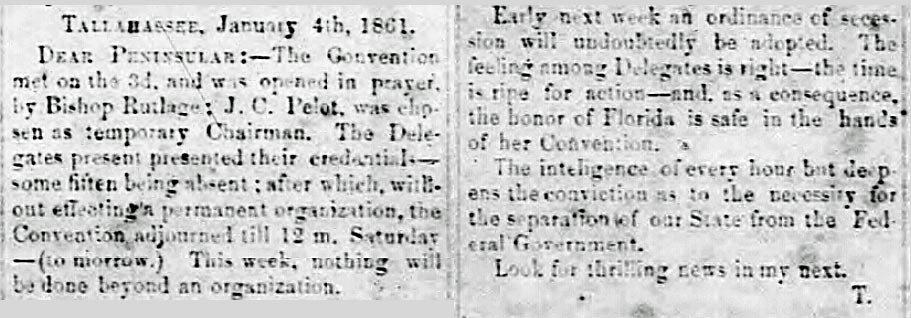
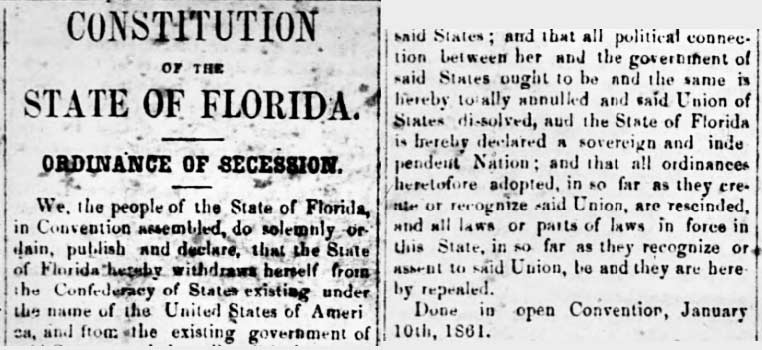
Jan. 10, 1861 Florida Ordinance of Secession from the
May
26 Florida Peninsular.
Several articles of the ordinance have been omitted here, see them
all
at the above link.
1861 - January 10
- Florida secedes from the Union
When the Senate reconvened in January, 1861,
Florida
became the third state to secede from the Union on Jan. 10th.
The
Convention met and approved Florida's secession from the Union by a vote of 62-7.
In the majority were Hillsborough’s delegates, Simon Turman and
James Gettis.
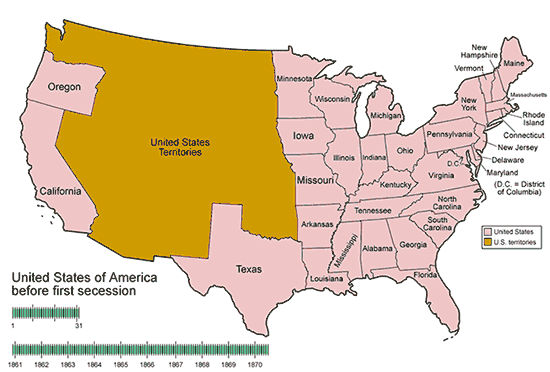
Animated map adapted from Tennessee Civil War History |
|
1861 - January 17 -
Senator Magbee instrumental
in creation of Polk County
On
Jan. 17, 1861,
Sen. Howell introduced legislation to create Polk
County from parts of Hillsborough and Brevard counties.
Magbee shepherded the bill through the Senate.
On Jan.
21, Senator David Levy Yulee read a statement of withdrawal to the
Senate, indicating that he and fellow Floridian Stephen R. Mallory
would withdraw from the Senate to support the Confederacy. On
March 14, 1861, the Senate declared Mallory’s seat vacant. Yulee’s
term expired on March 4, 1861, so no official Senate action was
necessary.
|
Creation of Polk County
According to Canter Brown, Jr., in his book None Can
Have Richer Memories: Polk County, Florida, 1940-2000,
after Magbee and Howell were elected, "...creation
of the new county thereafter proceeded in an orderly manner.
It was Howell, a longtime frontier dweller from near
Itchepackesassa, who introduced the legislation on Jan. 17,
1861, to create Polk County from parts of Hillsborough and
Brevard counties. The measure passed the House about two
weeks later, on Jan. 30. Magbee, a Tampa lawyer sympathetic
to frontier issues, then ushered the measure through the
Senate in less than a week, winning Senate approval on Feb.
4."
"Therefore, on Feb. 8, 1861, Polk was one of three proposed
counties signed into existence by Gov. Madison S. Perry. It
was named in honor of President James K. Polk, who took
office about the time Florida became a state. “Be it enacted
by the Senate and House of Representatives of the State of
Florida in General Assembly, convened, that from and after
the passage of this act, the Western part of Brevard county
and the Eastern part of Hillsborough county, shall form the
county of Polk, and that the said county of Polk be and the
same is hereby established,” states the law, Chapter 1201 of
the 1861 Florida Statutes, that created Polk County. The law
gave residents of the new county the right to elect their
own county officers, just as they had in Hillsborough
County, and to select by ballot a permanent seat of
government (the location was not dictated by law, but the
name was Reidsville). The first election was set to take
place immediately." |
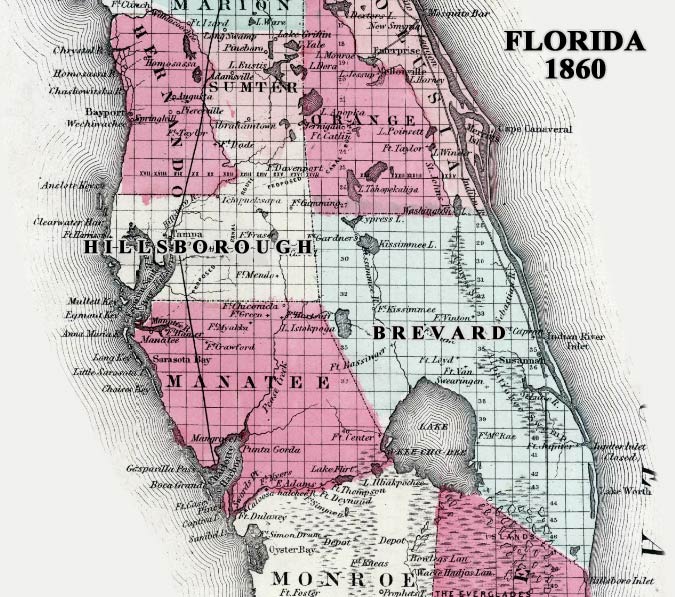
Maps, Etc. - Johnson's Florida, 1860 Johnson, A.J.,
Johnson's New Illustrated Family Atlas (New York, NY:
Johnson and Browning, 1860) |
|
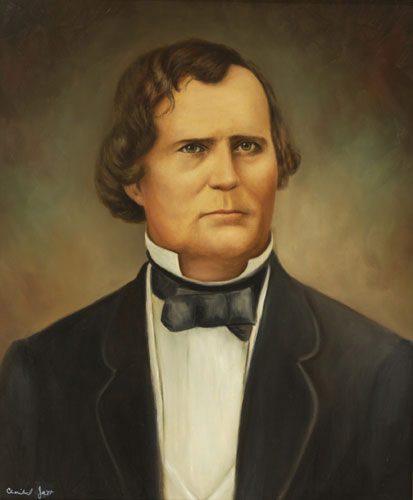 |
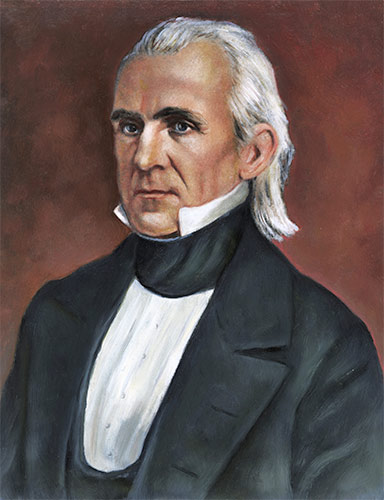 |
|
Florida
Governor Madison Starke Perry
Fourth governor of
Florida
October 5, 1857 to October 7, 1861
Portrait and info from
Florida Dept. of State
Madison Perry was born
in Lancaster District, South Carolina, in 1814. He
came to Florida in the 1830s and became a leader among
the area's plantation owners. As governor, Perry
helped bring about the settlement of a long-standing
boundary dispute with Georgia and encouraged the
building of railways. During the years before the
Civil War, Governor Perry foresaw the possibility that
Florida might secede from the Union, and in 1858 urged
the reestablishment of the state's militia. Florida
did secede three years later, on January 10, 1861.
After his term as governor ended, Perry served as
colonel of the 7th Florida Regiment until illness
forced his retirement. He died at his Alachua County
plantation in March 1865. |
President James Knox
Polk
Eleventh president of the
United States
March 4, 1845 to March 4, 1849
Portrait from History.com
Polk is known for
his policy of expansion which added Texas, California
and other territories to the U.S. Polk believed in the
westward expansion of the nation at any price and that
the ideal of expansion was the fate of the nation--he
believed it was a 'Manifest Destiny' for the country.
Polk was a member of the Democrat Political Party and
was 49 years old when he was inaugurated. In
1849 he was the first president in office to have his
photo taken. James K. Polk was born on November 2,
1795 in Mecklenburg County, North Carolina. He was
named after his maternal grandfather, who was a
militia captain during the American Revolution and
also took his mother’s family name. Polk was a distant
relative of John Knox who was the leader of the
Protestant Reformation in Scotland openly called for
the execution of Mary Queen of Scots. James Knox Polk
died on June 15, 1849 in Nashville, Tennessee.
Polk's careers included Lawyer, Politician and
Statesman. He was well educated at the University of
North Carolina and had military experience in the
Mexican War. He was the only president who was also
the Speaker of the House of Representatives. |
|
|
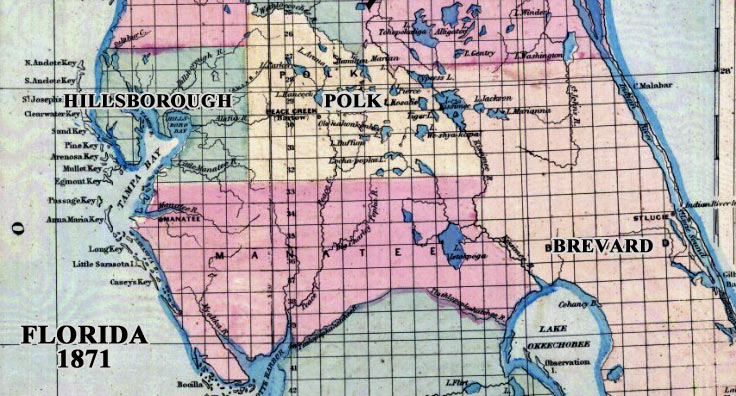
Florida, 1871
Maps Etc., Asher & Adams, Asher & Adams new commercial,
topographical, and statistical atlas and gazetteer of the
United States (New York, NY: Asher & Adams, 1871).
Courtesy of the private collection of Roy
Winkelman
|
|
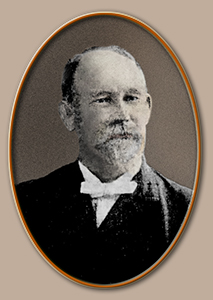 By James
McKay, Jr. in "Reminiscences - History of Tampa in the
Olden Days" Dec. 18, 1923 By James
McKay, Jr. in "Reminiscences - History of Tampa in the
Olden Days" Dec. 18, 1923
During the year
1860, Tampa continued to improve both as to business and population. To the best
of my recollection there were about 1,500 inhabitants. After the election
of Abraham Lincoln as president, considerable excitement followed, when in
January, 1861, Florida seceded and the climax was reached and every one went
wild.
Later on, the
militia was called out and every available man was put to work throwing up
breastworks and batteries at the mouth of the river, to resist an attack from
the United States navy, which we believed at that time we would wipe off the
face of the water.
[Thomas E. Jackson in 1924 estimated Tampa’s 1860 population
as 451 in the incorporated limits and 100 in the suburbs.] |
|
|
|
|
|
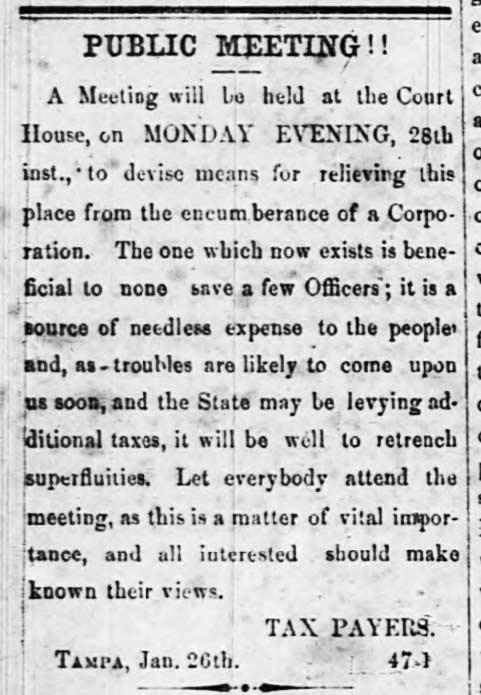 |
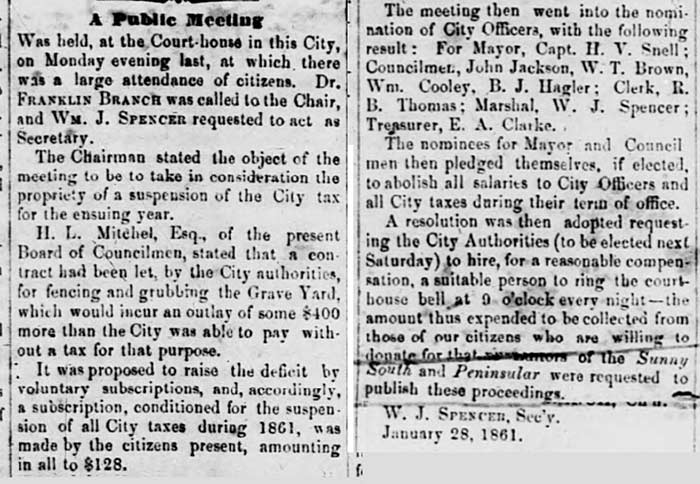 |
|
Jan. 26, 1861 Peninsular
Taxpayers hold a meeting to decide on unincorporation of the
City of Tampa |
Feb. 2, 1861 Peninsular
Report on minutes of the public meeting |
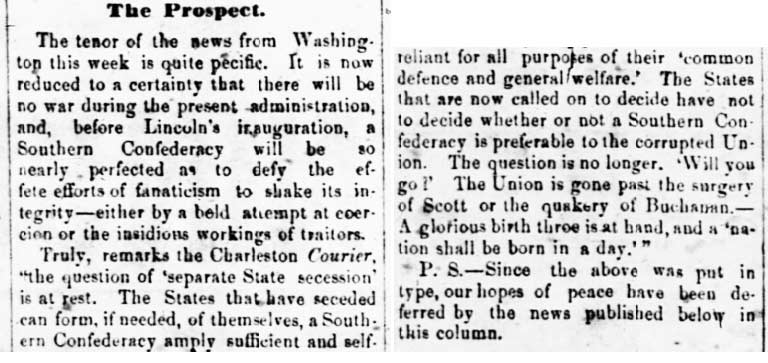
Feb. 2, 1861 Peninsular
Confederacy will be ready by the time of Lincoln's inauguration.
|
1861 - January Legislature
session continued
In addition to
the act forming Polk County, Magbee introduced a treasury
act** to produce funds for the state, a bill that donated
the Fort Brooke reservation to Hillsborough County and a
bill granting land warrants to military veterans.
(**The
treasury act is lengthy and has been cut from the image
below.)
Feb. 23, 1861 Peninsular |
|
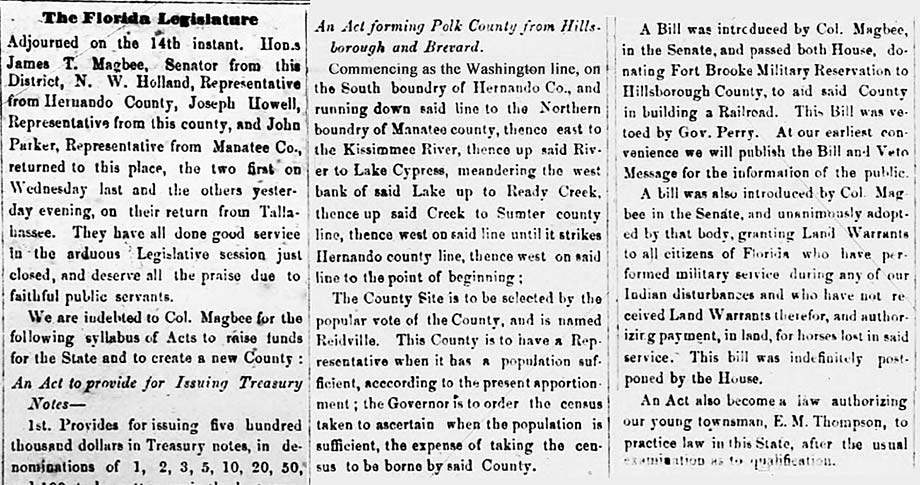 |
| |
In the paragraph directly above,
"County Site" should be "County Seat."
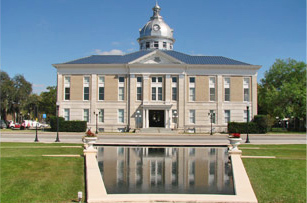 |
|
|
During its first six
years, Polk County had no official county seat. The 1861
legislation creating the county directed voters to select a
courthouse site. In fact, the legislation went so far as to
name the county seat-to-be "Reidsville," possibly after Sam
Reid, an early surveyor of the Peace River valley. In 1862
cattle baron Jacob Summerlin purchased the site of Ft.
Blount on the Peace River and donated land for schools,
churches, and a courthouse. The name Reidsville was
abandoned for that of General Francis S. Bartow, recently
killed at the first battle of Manassas, one of the first
Confederates of high rank to die in the Civil War. Bartow,
nicknamed "City of Oaks and Azaleas," has remained the
county seat through the present day.
Florida's 10th Judicial Circuit - Polk County Courthouse |
|
Magbee returned home on Wed., Feb. 20 from the Senate session in time to speak at (ironically) the
George Washington Birthday celebration
on February 22, 1861.
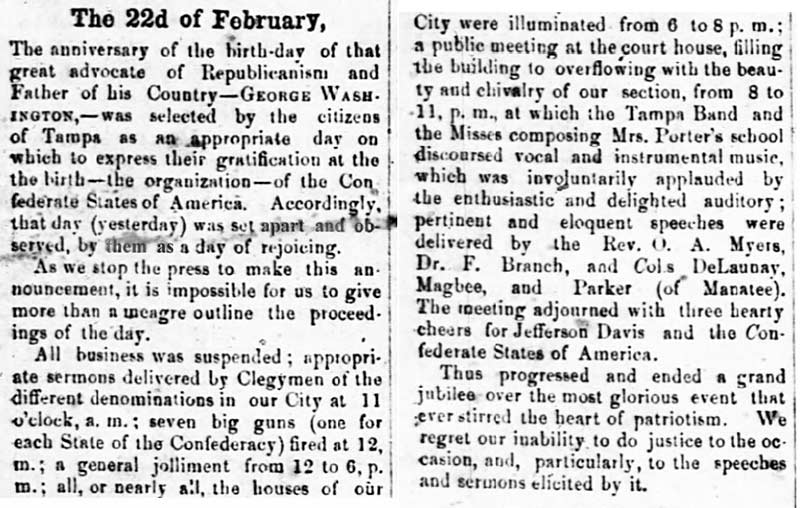
Feb. 23, 1861 Peninsular
|
|
|
|
Tampa’s 8th Mayor
HAMLIN
VALENTINE SNELL
Land owner, State Legislator, Collector of Customs
Term: February 2, 1861 – May, 1861
Born: 1810, Savannah, GA.
Died: Jan., 1886, Gainesville, Fla.
Hamlin Snell moved to
Calhoun County, Florida in the late 1830s where he
served as the county’s representative in the 1840
Legislative Council. In 1842, he moved to Sarasota where
he established a small plantation and is credited as the
first person to plant guavas in Florida, which he
imported from Cuba.
Snell sold his
plantation and relocated to Manatee County where in 1851
he was elected State Senator for the 18th District
which, at that time, included Hillsborough, Levy and
Hernando Counties. During his time as senator, 1852 -
1855, he was elected President of the Senate in 1854 and
introduced the bill which created Manatee County.
From Nov. 24th, 1856 to Dec. 27, 1856, he served as
Speaker of the 8th session of the State House.
Snell resigned and moved to Tampa in late 1857
where on June 19, 1858, he replaced James T.
Magbee as deputy collector for the Port of Tampa.
Snell continued to take
an active role in local politics which led to his
election as Mayor of Tampa in January 1861. However, by
February 1861, war preparations between the southern and
northern states were having its impact on Florida.
Tensions between Tampa's small but influential number of
unionists and the secessionist majority became
increasingly violent. Most Unionists left Tampa for Key
West where they received protection from federal troops.
On hearing the news that Confederate guns had fired on
Fort Sumter, Mayor Snell proclaimed a day of
celebration.
On April 21, 1861 the
20th Florida Regiment assumed command at the abandoned
Fort Brooke and declared Tampa under Martial Law. City
government continued to operate, but its activities were
subject to the approval of the Confederate commander.
The value of Tampa’s port was recognized by both the
Union and Confederate governments and soon the first
ships of the Union Blockade appeared in Tampa Bay. Snell
and other City officials served without pay during most
of their term when all City salaries were cancelled
after May 20, 1861. Snell resigned as Mayor and
hurriedly left Tampa after selling his properties. At
present the reasons for Snell's rapid departure have not
been researched. One possible explanation is that he
realized Tampa could not be effectively defended against
Union invasion from the sea and had no desire to remain
in the city.
Hamlin Snell never
returned to Tampa and, in January 1886, passed away in
Gainesville, Florida. |
|
List of Speakers of the Florida House of Representatives
The Mayors of Tampa 1856 - 2015,
A project of the City of Tampa
City of Tampa past Mayors, Hamlin V. Snell 7th Mayor Of Tampa
|
|
Feb. 23, 1861
Peninsular |
|
|
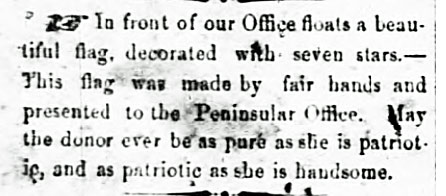 |
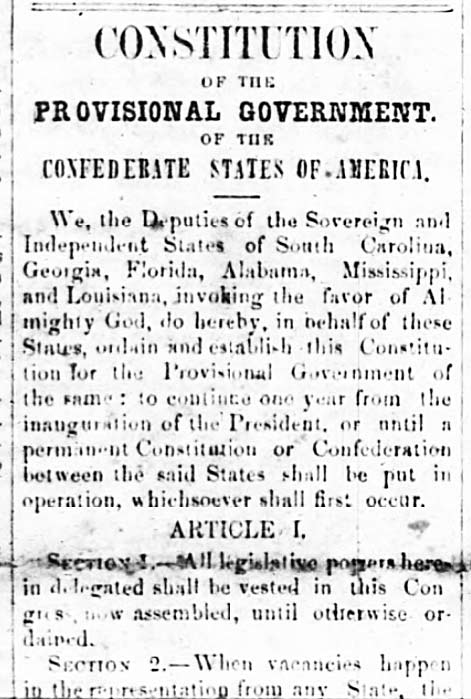 |
| |
|
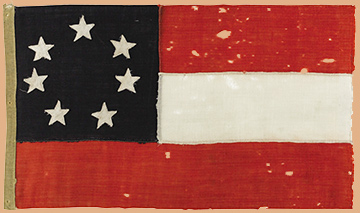 |
|
The Confederate
Battle Flag
The seven stars represented the original Confederate
States; South Carolina (Dec. 20, 1860), Mississippi (Jan.
9, 1861), Florida (Jan. 10,1861), Alabama (Jan. 11, 1861),
Georgia (Jan. 19, 1861), Louisiana (Jan. 26, 1861), and
Texas (Feb. 1, 1861). |
| |
|
|
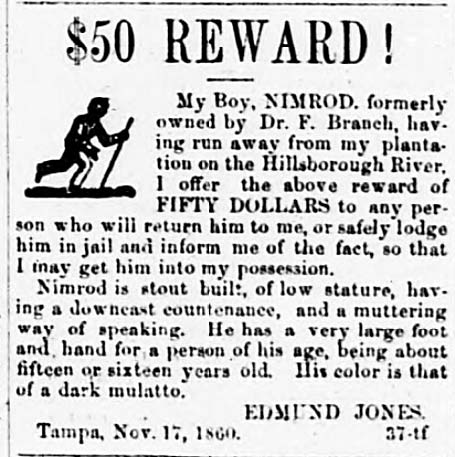
The $50 reward ad
had been running since Nov. 17, 1860.
Dr. Franklin Branch was the owner of the Branch Opera
House on Franklin St. |
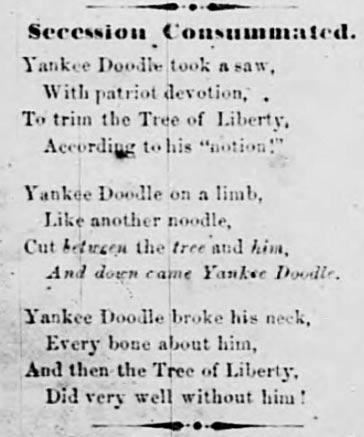
Jan. 26, 1861 Peninsular
|
|
James McKay
and
Jean St. Shipyard |
|
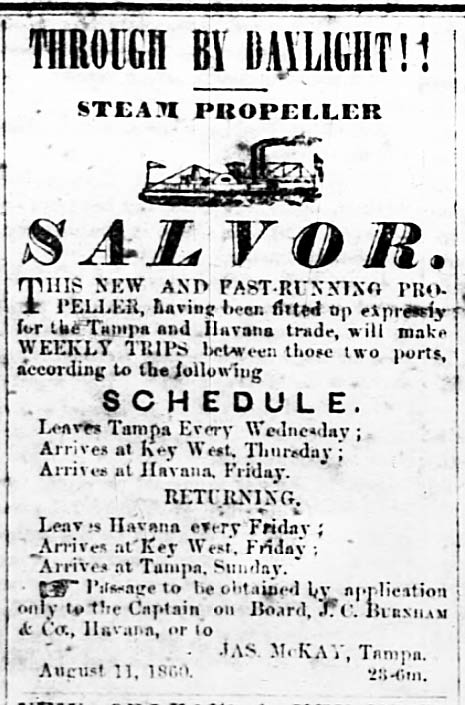
Feb. 1, 1861 Peninsular |
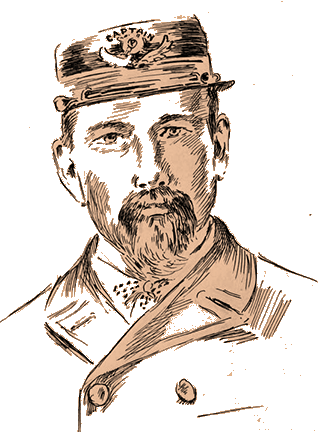
Captain
James McKay, Sr.
Sketched by Philip Ayers Sawyer in 1938 from an old photo in the
home of James' son, H.C. McKay.**
State Archives of Florida
**James Sr. didn't have a son with H.C. initials.
|
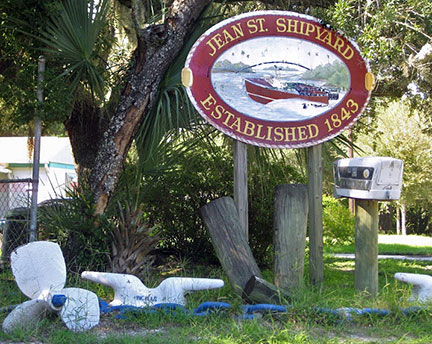
Image
from Jean St. Shipyard website
The Jean Street Shipyard (est. 1843) is a shipyard located on the
Hillsborough River in Tampa. It is located approximately 5 miles
from the mouth of the Hillsborough River, about 1 mile above the
Hillsborough Avenue bridge in what is now the neighborhood of
Seminole Heights. It is a full service shipyard with wet slips and
a Travelift for hauling vessels from the water.
The shipyard was first established in 1843, as
far upriver as was navigable on good solid ground. This allowed
the shipyard to be surrounded by good quality shipbuilding
material, as well as protect it from storms and weather. A massive
wharf was built for the loading of local cargo, but the primary
function of the shipyard was servicing and repairing riverboats,
skiffs, barges, and local sloops. The site was equipped with a
machine shop, wood shop, a marine hardware store, and railways for
hauling vessels from the water. James McKay, a schooner captain,
was one of the first owners of the shipyard and used the
facilities to maintain his cargo and trading vessels, including
steamships, schooners, sloops, skiffs, and barges. McKay was
heavily invested in Tampa, owning a general store and a sawmill.
He also owned two schooners that he used in the cargo trade with
Cuba, Central America, and South America. McKay was elected mayor
of Tampa in 1859.
|
|
McKay, an experienced
sailor and seaman, is well known to Tampa history as a wealthy and
successful businessman who owned the local salt works. He is
credited with organizing the “Cowboy Cavalry” to supply beef to
the fighting Confederate Army.
Around the time of
the start of the Civil War, the
Jean Street shipyard on the Hillsborough River was owned and funded in part by
James McKay, and another local Tampa
businessman, David Hope. McKay also owned and operated a shipping line
that ran from Tampa to Havana.
McKay, however, is
probably best known for, and perhaps immortalized for, being a
daring and brazen blockade runner. In spite of the Union’s efforts
to cut Tampa off from the rest of the world, he and his fleet of
blockade runners helped to keep Ft. Brooke and the citizens of
Tampa supplied with goods and able to continue outside trade.
During the Civil War
the Union controlled the waters of Tampa Bay from its Naval base
at Egmont Key. It also controlled most of the Gulf of Mexico from
its Naval and Army bases in Key West, making it no easy task to
get past a blockade. Both McKay and Hope owned and operated
blockade runners during the Civil War. Jean Street Shipyard
serviced these vessels, and as such became indirectly involved in
the battle.
The Hillsborough River Raid and the battle of Ballast Point, at
Jean Street Shipyard |
|
1861 - Magbee begins a campaign against McKay
John T. Lesley
was a prominent cattleman and like many of the prominent men
in Southern communities at the onset of the Civil War formed
a military company at his own expense. Lesley’s Tampa troops
who were later described as coming from “the best families
of the town and vicinity,” trained and paraded through Tampa
streets while waiting two months to be sworn in.
|
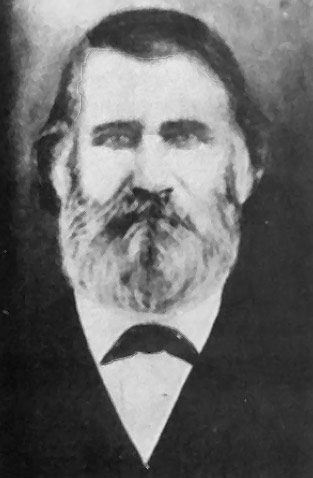 |
|
|
Major William Iredell Turner,
Staff, 8th Florida Infantry
Residence Tampa FL; 49 years old.
Enlisted on 9/15/1861 at Tampa, FL as a Captain.
On 9/15/1861 he was commissioned into K Co. FL 8th
Infantry. He Resigned on 9/17/1862
Promotions: Major 7/5/1862
Intra Regimental Company Transfers: 8/5/1862 from
company K to Field & Staff
Born 6/7/1812 in Richmond, VA
Died 10/28/1881 in Manatee County, FL
Prior service in US Army. Served in Seminole War.
Photo & info from Find-a-Grave
|
|
Unfortunately, some
of the Lesley’s youngsters were more used to parties than digging
the earth works ordered by Col. William I. Turner, commander of
Fort Brooke and a veteran of the Second Seminole War. This lack of
discipline led to problems.
In one instance
in April 1861, Lesley and his men refused to obey the direct orders of Turner, a
colonel in the state militia. They had seized and refused to
return a fishing smack they believed to belong to the controversial James McKay
whose business dealings, including selling Florida beef and
supplies to Unionists in Key West since 1858, placed his loyalty
to the Confederacy in question. The high jinks by Lesley’s men
angered fellow merchant, John Darling and others who wanted the
men placed under Turner’s authority.
Tampa’s citizens
informed Governor Madison Perry
of the conflict at Fort Brooke and Turner’s strict conformity to
orders
in a letter dated June 27, 1861. McKay wrote and asked the governor to clarify for Lesley
and his men that they were subject to his friend, Turner’s
authority.
Magbee
responded to McKay in a letter to the Florida Peninsular, July 19,
1861.** After comparing McKay to Benedict Arnold, Magbee wrote:
"Former differences I
burn upon the altar of my country and will to the last moment
stand side by side with any one in the cause of the South. She
is now entered into a Just and Holy war, in which every man,
woman and child is and should feel interested and we have not
the right to cater to the views and interests of friend or foe,
whose conduct cannot meet the smiles and plaudits of our
country, the land of the "stars and bars," the home of the
patriot where the only temple of true fealty has been preserved.
I am a Southern man by birth, was reared and educated in
Georgia, was born a slave owner and have owned slaves all my
life and am also an undoubted secessionist."
**All Florida
Peninsulars of July 1861 through April 1866 are missing.
|
|
|
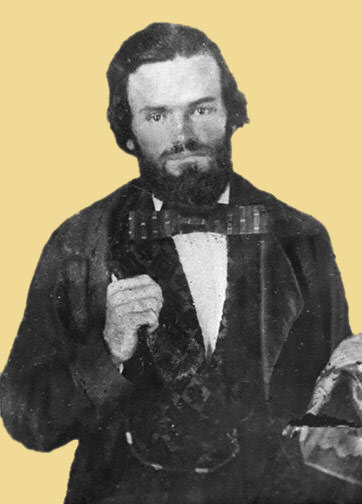
John Thomas
Lesley on his wedding day when he married Margaret Brown
Tucker, widow of William W. Tucker.
Photo from Florida Memory State Archives
There were few aspects in the life of the young community of
Tampa that Capt. John Thomas Lesley (1835-1913) did not
touch in some significant way. At the age of 25, Lesley had
already become one of Tampa’s leading citizens. Born in
Madison County, Florida, John Lesley moved to Tampa with his
family in 1848. During the Third Seminole War, Lesley joined
the Florida militia as a private but quickly was promoted to
lieutenant. He became a cattle rancher and at the outbreak
of the Civil War, he formed a company of Tampa men and was
elected its captain. In October 1862, Lesley was
commissioned a major in the Confederate Army.
At the end of
the war, Lesley returned to Tampa where he worked to
establish his financial and social position. During the next
several years, Lesley served as sheriff for two years and
built a sawmill that supplied much of the lumber used to
re-build the town. He later became a state legislator. |
|
Magbee
then began a
campaign in the Peninsular to have McKay arrested for petty
treason.
Gov. Perry agreed
with McKay, but Lesley's unit was mustered out before McKay’s boat
was returned. Col. Turner was replaced in late July by Florida
Militia General, Joseph M. Taylor.
The Robles Family During the Civil War in Tampa, by Karen
Lucibello
|
1861 - April
21 - Confederate command takes over Fort Brooke
|
On April 21, 1861, the
20th Florida Regiment took over the abandoned Fort Brooke
and the Confederate military commander declared Tampa
under marshal law, dismissed the mayor, city council and
other employees and essentially nullified the authority of
the town's government. About three weeks later, current
mayor Hamlin Valentine Snell hurriedly left Tampa after
selling his properties.
John Jackson
took over as
acting mayor in May, 1861.
|
|
Tampa’s 9th Mayor
JOHN JACKSON
Engineer, Surveyor, Merchant
First Term: May, 1861 –
February 3, 1862 - Acting Mayor
Second Term: Feb. 3, 1862 – Feb. 22, 1862
Born: June 1809, Ballybay, County Monaghan, Ireland
Died: November 4, 1887, Tampa, Florida
|
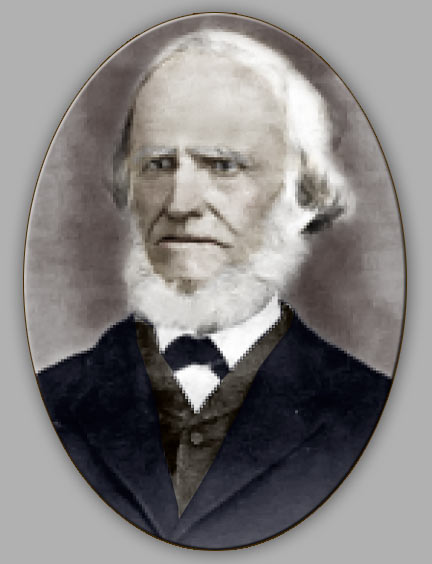 |
|
See earlier info about Jackson
as a surveyor previously presented in
this feature.
While on a surveying assignment in 1847 St. Augustine
he met Ellen Maher and they married there on July 22, 1847.
He and Ellen Maher had four children: Thomas, James, Kate,
and John. In 1849 they came to Tampa where he and his
wife established a general store on the corner of Washington
and Tampa streets. They also led a movement to have a
Catholic priest brought to Tampa. His children were the
first in Tampa to be baptized in the Catholic faith.
Jackson served as acting
mayor when Hamlin Snell resigned in mid-May, 1861, until his
election February 3, 1862. |
|
|
|
|
James McKay had
been shipping cattle to Cuba since 1858-59 and although
the war had broken out April 12, he continued the trading,
not only selling cattle in Cuba but also to U. S. troops
in Union-controlled Key West and the Tortugas.
Magbee seized on these resolutions below to gain support for
McKay's arrest when he returned to Tampa.
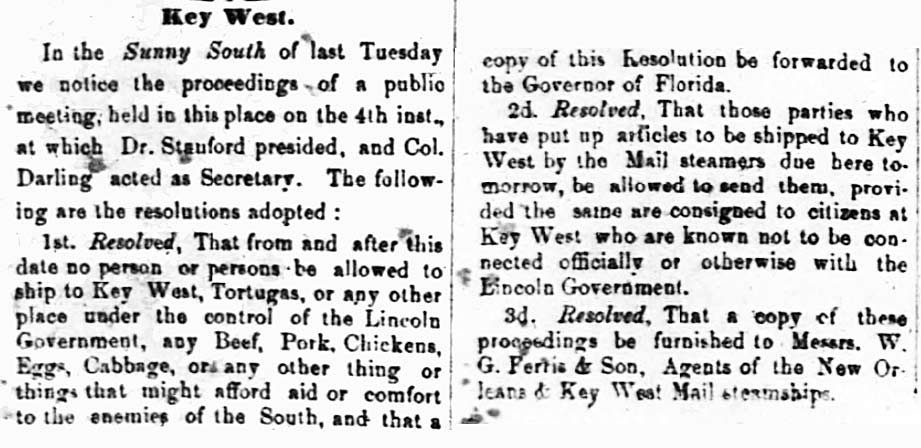
Florida Peninsular - May
11, 1861
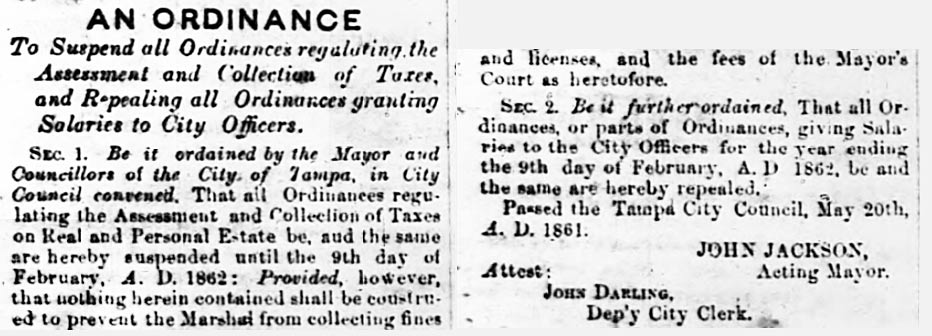
Florida Peninsular - May 25, 1861
This is the last Florida
Peninsular available until May 5, 1866
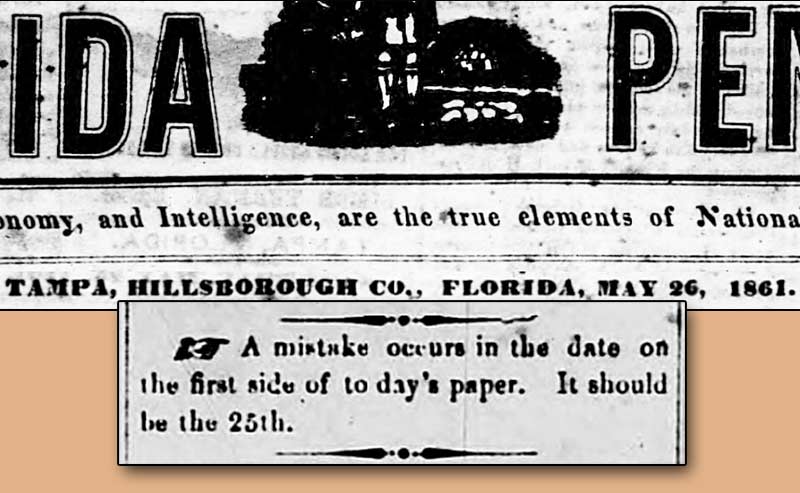
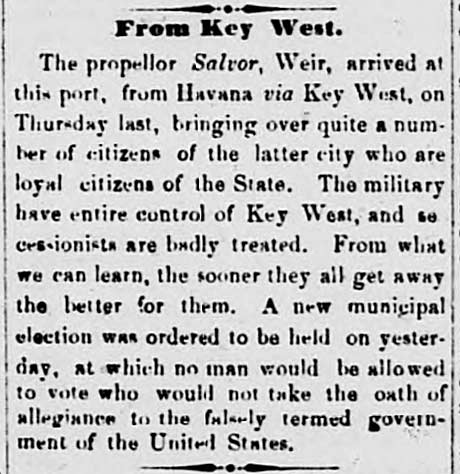
From the
Florida Peninsular - May 25, 1861
The Salvor and the Weir arrived in Tampa bringing
secessionist citizens ("loyal citizens of the State") from
Key West who were being treated "badly" by the
U.S. military in Key West.
| In
the summer of 1860, McKay experienced a disaster due
to the late arrival of his new ship, the Salvor.
Modifications to the Salvor in New York took longer
than expected so thousands of his cattle died of
thirst while waiting to be shipped south from Tampa.
This resulted in McKay and other cattlemen to shift
their operations from Tampa to the Peace River at
Charlotte Harbor in order to take advantage of the
better opportunities for selling cattle from there.
The
Republican presidential victory and the ensuing
clamor for secession prompted McKay and other
cattlemen to step up their operations.
Business was booming for McKay as he made numerous
runs to Key West, Cuba and the Tortugas. This
opened a "Pandora's box" for McKay.
On
June 6, 1861, McKay's cattle boat Salvor was
detained by the U.S. Navy at Key West. The
Navy then leased the ship from McKay for their own
use and allowed him to return to Tampa in a fishing
smack. Soon after his arrival in Tampa, McKay
was arrested for treason and charged with supplying
beef to the Union enemy.
Florida's Peace River Frontier, by Canter Brown, Jr. |
| |

July 16, 1861 - Savannah Daily Morning News - More of
Lincoln Despotism
Schooner Dudley arrived in Tampa on July 2 with preacher
who was arrested and jailed
for praying for Confederacy in church at KW on Jun 23.
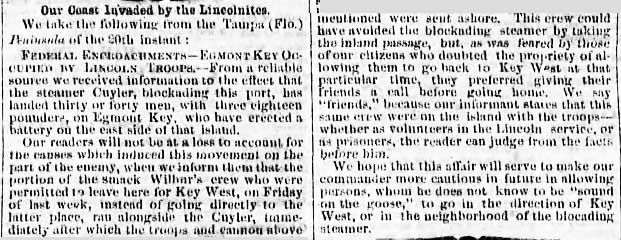
July 30, 1861 - Savannah Daily Morning News - Coast
invaded by Lincolnites
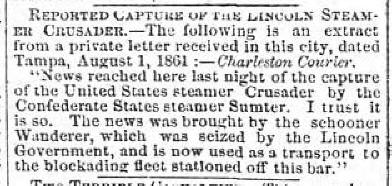
Aug. 12, 1861 - Savannah Republican - Report of capture of
Lincoln steamer Crusader |
1861 - Aug 10 - Sen. Magbee is prosecutor in controversial James McKay
trial
|
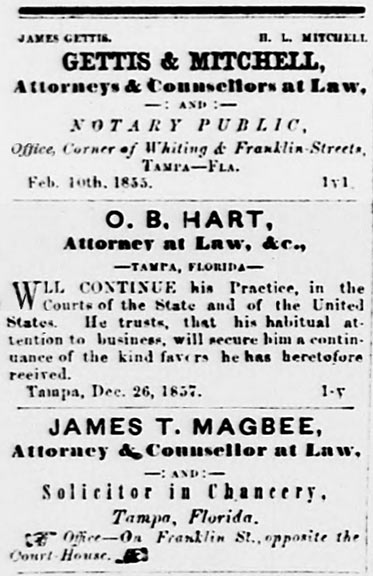 |
|
Ads for Gettis, Hart
and Magbee appear one right after the other on the front
page of many issues of the Peninsular.
These from May 21, 1859. |
On
August 10, 1861, Magbee once again entered the political
arena, this time in the highly controversial McKay treason case.
Court was not in session at the time, so McKay’s trial was held
before two justices of the peace at the Hillsborough County
courthouse on August 10. McKay was represented by James Gettis and Ossian B. Hart. The
volunteer prosecutor was none other than Senator James T. Magbee.
|
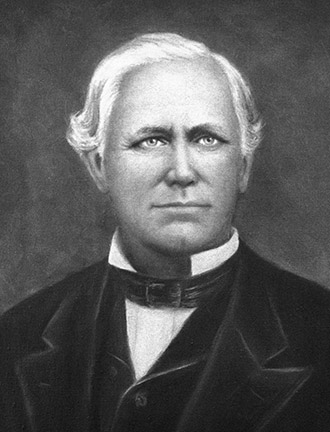 |
|
Ossian B. Hart
10th Governor of Florida, and first governor of Florida who
was born in the state.
Wikipedia |
McKay
believed that "the whole matter originated through malice of two
or three dishonest Govt. officials, who, a few years before, I was
instrumental in having removed from office for their bad acts" [referring
to Magbee.]
Cattlemen associates of McKay’s offered, in his words, “to come in
mass and break up the justice court,” but the defendant declined
their efforts.
McKay's defense was
ably conducted by Tampa lawyer and future Republican Governor Ossian Bingley Hart,
a Tampa Unionist,** and James Gettis, McKay’s personal lawyer and a
northern-born secessionist. Also, McKay’s friend, militia
Brigadier General Joseph M. Taylor, as a local man put it, “sat
himself on the trial."
**In
the United States, Southern Unionists were white citizens living in
the Confederate States of America, opposed to secession, and
against the Civil War. These people are also referred to as
Southern Loyalists, Union Loyalists and Lincoln Loyalists.
James McKay's
trial is continued after the Gettis profile below.
|
James Gettis
When 32-year-old Pennsylvanian James Gettis arrived in Tampa
in 1848, he doubled the local lawyer population. Born
May 4, 1816, he graduated from law school in Pennsylvania
and practiced in that state until he moved to Hillsborough
County. Gettis never spoke of his family, for personal
reasons known only to himself, even when directly questioned
about them. He had practiced law in his home state but
friends believed that disagreement with his family, over the
issues that led to the War Between the States, prompted his
removal to Florida.
The first
recorded session of circuit court in Hillsborough County
occurred in April 1846, although an earlier term was held in
the fall of 1845, no records remain. Georgia-born James T.
Magbee, Tampa's first practicing attorney, was admitted to
the bar in April 1846 and not until October 24, 1848 was
another Tampan admitted to practice. On that date, James
Gettis was examined by attorneys Magbee and Thomas E. King
and found qualified to practice law in the courts of
Florida. The court minutes show that Circuit Judge Joseph B.
Lancaster granted his approval to the admission of Gettis.
He had several students of law under his tutelage including
Henry Laurens Mitchell, later Governor or Florida; and John
A. Henderson.
|
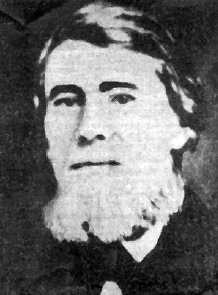
James
Gettis, from a larger group photo of the 1861 members of
Florida's
Secession Convention in Tallahassee.
Florida Memory-State Archives
|
|
On August 10, 1850,
James Gettis was initiated an Entered Apprentice in
Hillsborough Lodge No. 25, Free and Accepted Masons and was
raised a Master Mason on September 17, 1850. For the
remainder of his life, Gettis remained a loyal and active
Freemason. Though northern-born, James Gettis soon earned
his bona fides as a Southerner. He owned no slaves but
strongly supported the institution. Gettis, a member of the
controversial "Know Nothing" party, was active and vocal in
politics. He was city councilman, a state representative and
later a judge, as well as tireless promoter of Tampa's
development.
He was elected
Representative to Legislature for Hillsborough County and
was Solicitor for the Southern Judicial Circuits of Florida;
was a Circuit Judge, delegate to the Secession Convention of
1860 (voting for secession) and was elected Chairman. He was
also a Delegate to the Constitutional Convention of Florida
in 1865. During the Civil War, he organized his own Company
and was elected its Captain. Captain Gettis served in the
Company from 10 April 1862 until he resigned on 17 April
1863, due to ill health, at that time he served in the Tampa
City Guards. As a bachelor, upon his death all of his
property was left to James F. Henderson, executor of his
estate. He is buried in Tampa's Oaklawn Cemetery.
|
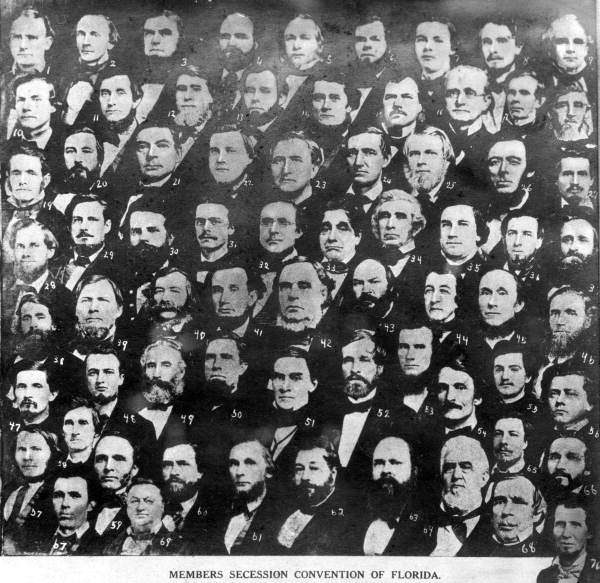
1861
Florida Secession Convention members, Gettis 2nd row, 3rd
from left, #12. Click to see larger |
|
City of Tampa Parks & Recreation Dept., Oaklawn Cemetery
The South Florida Rifles, Officers Biographies
THE SUNLAND
TRIBUNE, Journal of the TAMPA HISTORICAL SOCIETY, Volume
XXIII November, 1997 - JAMES GETTIS: TAMPA PIONEER LAWYER By
KYLE S. VanLANDINGHAM
|
|
1861 - Sen. Magbee is prosecutor in controversial James
McKay trial (continued) |
|
At
McKay's trial, which was described as "long and acrimonious,"
Magbee
prosecuted the case with vigor and
called for the death penalty, demanding that McKay be
hanged.
However, the Justices of the Peace, after the intercession of Gen.
Joseph M. Taylor, commander at Fort Brooke,
Ossian Hart, Gettis,
and a number of cattlemen who pressed the justices to set McKay
free on bail,
avoided judgment
by binding the captain over for a new trial at the October term of
the circuit court. Taylor also arranged
for McKay to pass the new Union blockade and head for Key West.
McKay was required to post a bond of $10,000. Soon after, McKay was allowed to leave Tampa and resume his
business activities. He went back to Key West.
In mid-August Taylor
left Fort Brooke and J. T. Lesley began his short stint as commander
there. In less than two weeks he and his men were transferred to
Shaw Point on the south side of the Manatee River. His unit came
under the new commander of Fort Brooke, Major Wylde Bowen from
Lake City who brought his two companies of the 4th Florida Infantry
formerly of the Cedar Keys.
The Robles Family During the Civil War in Tampa, by Karen
Lucibello
|
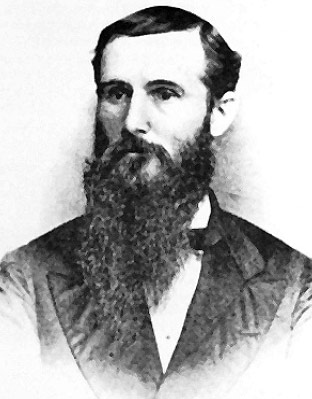
Maj. Wylde Lyde Latham Bowen
The Sunland Tribune, Journal of the Tampa Historical
Society,
Volume XVII November, 1991 Journal
of the Tampa Historical Society
-
Tampa's
Forgotten Defenders, By Zack Waters. |
|
THE CIVIL
WAR IN TAMPA
Florida's gulf
coastline geography and sparse population provided an ideal
setting for resourceful sea captains with small ships to
slip past the Union ships blockading the east gulf coast.
The U.S. Navy kept a close eye on Florida's ports and patrolled
the coastline, sending armed expeditions ashore to destroy Confederate
facilities. Tampa's large bay offered many places of hiding for blockade-running
vessels, so it drew much attention from the Union Navy.
To support
the blockade and control Tampa Bay, the Navy kept a base of operations and a
coal station on Egmont Key, located about 35 miles from Fort
Brooke, where Tampa Bay joins the Gulf of Mexico. The key's
small civilian population was mostly made up of northern sympathizer taking
refuge on the small island.
Early confrontations in the bay
area could be described more accurately as "skirmishes" or
"squabbles" between resident Unionists and Confederate troops comprised of local
citizens. But engagements on land and sea became more serious when crew
members of Federal ships started going ashore and raiding the local salt works.
Salt
processing facilities were built in the shallow salt waters
along the gulf coast, where seawater was boiled in large
kettles so the water would evaporate and leave the salts
behind. When Union salt factory raiders began to be
ambushed by the local Rebels, the Navy changed its strategy
and began to shell the salt factories before sending troops
ashore to finish the destruction.
Fort Brooke, with its ideal
location, provided excellent protection for the area during the Seminole wars and served as a marshaling
point for troops going to Mexico during the Mexican War. But when the
Civil War started, Confederates took over the fort, and the cannon that once
had protected Tampa from Indians were turned facing the river
in expectation of a Union invasion. Directly south of Fort Brooke, in
Hillsborough Bay, were some mud flats, the largest was known as Big
Grassy Island. Any ship coming in from south had to pass the island to get to the Hillsborough River.
The Hillsborough River Raid & Battle of Ballast Point
|
EGMONT KEY IN THE CIVIL WAR
From PARADISE LOST: FLORIDA’S EGMONT KEY DURING THE CIVIL
WAR By Angela Zombek | August 31, 2016
The
story of Egmont Key is not that of a major battle or a
significant individual. Egmont Key’s story is about local
resistance, disease, and the fight for survival. It reminds
the public that the sectional conflict reached even the
distant corners of the divided nation and illustrates the
challenges that war thrust upon the settlers on the Florida
frontier.
In the mid-nineteenth century, the Tampa Bay area was a
sparsely populated borderland rife with mosquitoes and
disease. Indeed, in 1861, one New York Times correspondent
denounced it as a “miserable, God-forsaken hole.” But
the U.S. government disagreed and, even years earlier, had
perceived the strategic value of Tampa Bay and of Egmont
Key, which stands guard where the bay’s shallow waters meet
the Gulf.
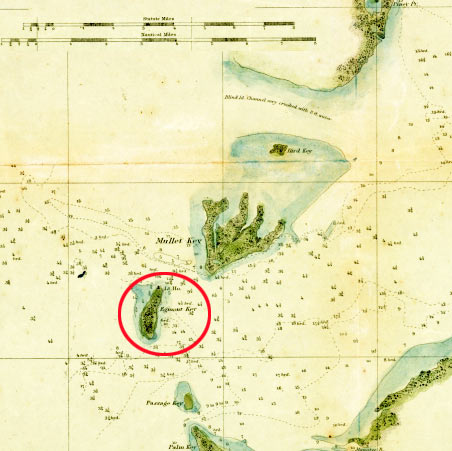
1855 Nautical map of entrance to Tampa Bay
From Florida Memory, State
Library & Archives of Florida
When Florida became a state in 1845, recognition of the
bay’s importance heightened. The following year, Florida’s
senators pressured Congress to appropriate funds for a
lighthouse to guide ships into Tampa Bay. Three years later,
a group of army engineers, led by young U.S. Lt. Col. Robert
E. Lee, recommended fortifying the Key. Fortifications did
not materialize, but Congress appropriated ten thousand
dollars to construct a lighthouse, which began operating in
May 1848.
A few months later, on September 25, 1848, a hurricane
inundated the Key with six feet of water, damaging the new
beacon. The U.S. Congress responded on August 10, 1856, by
appropriating sixteen thousand dollars for a new lighthouse.
This structure, completed in 1858, stood eighty-seven feet
above sea level and could “withstand any storm.” The
sturdy lighthouse has needed very few repairs over the
years, but one resulted from the actions of loyal
Confederates during the Civil War.
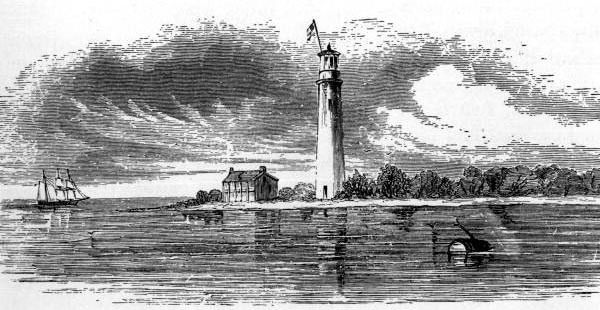
Egmont Key Lighthouse, 1862
From Florida Memory, State Library & Archives of Florida
|
| |
1861 - Death of Susan Tatum Magbee
In November 1861, Sen. Magbee returned to Tallahassee for the
upcoming legislative session. There, he came close to being
elected to the Senate of the Confederate States of America. Magbee's wife, Susan
A. Tatum Magbee,
died at age 33 on Nov. 18, 1861. There is not a record of her
burial in the Magbee plots at Oaklawn or Woodlawn cemeteries.
|
James McKay blockade-running and capture
Most of the
Tampa area population sided with the Confederacy, and one
of the most prominent of Tampa's was Captain James McKay,
the owner of two blockade runners, among other vessels.
McKay was a
master seaman from Thurso, Scotland, who brought in a large amount
of cash from his business ventures and eventually
became city mayor and local
hero.
In 1859,
McKay bought several ships and started shipping cattle
from Tampa to Havana, and then from Charlotte Harbor to
Key West, Havana and Tortuga. The Cubans paid him in gold,
enabling McKay to expand into other businesses. He
continued to operate these businesses during the Civil War
while also handling supplies for the Confederacy. It was
common for McKay to lead herds of cattle northward to
supply Southern troops with his much-needed beef.
After reclaiming the Salvor in
Key West from the Union command's 3-month lease, McKay took
it to Havana for repairs.
On October
13, 1861, McKay was traveling with his son and crew from
Havana aboard his steamer Salvor when he was captured by the USS Keystone State. A
search of the Salvor reportedly found 600 pistols and rifles, 500,000
percussion caps, coffee, cigars and clothing.
They were brought into Key West where McKay, his son
Donald,
and his crew became prisoners of war and his steamer
was confiscated.
McKay felt
that his ship, the Salvor, which was sailing under the
British flag as the MS Perry, was wrongfully seized by the
Union, claiming he had sold it to a British subject in
Havana.
The Salvor
and its cargo, along with McKay's young son Donald, the
crew, and McKay's slaves, were towed to Philadelphia, while
McKay, and two passengers were detained at Fort Taylor in
Key West. From Philadelphia, Donald McKay and the crew were sent to
prison at Fort Lafayette off the coast of the Bronx in New
York, where they were eventually released on different dates
for various reasons.
It was only after
five months, at a
considerable cost and through the personal intervention
of President Lincoln, that James McKay was allowed to take an oath of allegiance
and was paroled.
See details of this on this separate page:
THE CAPTURE OF THE
SALVOR and MCKAY'S IMPRISONMENT
On April 21, 1862,
McKay
was back in Key West and returned to Tampa in mid-May.
Part of the
condition of McKay’s pardon was a promise not to return to
the service of the Confederate cause, a promise the now
bitter McKay abandoned immediately upon his return to Tampa.
Upon his return he
armed the Scottish Chief with a 6-pounder cannon, and went to work eliminating a fleet of
small boats which were fishing with "illegal fishing
contracts" along the lower west coast of Florida and were also spying. This fleet of small boats was
supplying federally-controlled Key West not only with Florida
fish, but also with information about Confederate ships and their positions to the Union army
based at Key West. The Scottish Chief captured 24 small
boats and their crews, thus making Florida waters safer,
but earning a vendetta against him from the Union.
This
vendetta would eventually cost him dearly. Later, according to
Union records, it was the destruction of McKay's two vessels, and
nothing more, that was the actual focus of a attack against Tampa
in October 1862, dubbed the
Hillsborough River Raid.
The Hillsborough River Raid then led to the Battle at
Ballast Point.
After the capture of these “illegal fishing boats” for the Confederacy,
McKay continued blockade running with his sailing sloop, the
Kate Dale, and his prize vessel, the
Scottish Chief. He made six more successful runs past Union
vessels with Scottish Chief.
At first
he carried beef to Havana but as beef became more vital to the Confederacy
and the Florida legislature outlawed the export of cattle, he
shifted to cotton. For the relief of the remaining Tampans he also
brought in medicines, rum, foodstuffs and other supplies.
The relief offered to
Tampa by McKay and the other local blockade runners so rankled
Union blockaders that on several occasions Union ships entered
Tampa Bay to reek mischief and remind Tampa citizens that they
were being blockaded.
By October
1863, McKay was ready to make another run with bales of
cotton through the blockade with the Scottish Chief and
his new vessel Kate Dale, a small sailing sloop, neither
of which drew more than 4 feet of water.
Congressional Edition, Volume 3788
Hillsborough River Raid.
The Hillsborough River Raid and Battle of Ballast Point
|
EGMONT KEY IN THE CIVIL WAR
From PARADISE LOST: FLORIDA’S EGMONT KEY DURING THE CIVIL
WAR By Angela Zombek
In July 1861, approximately thirty to forty U.S. seamen
from the steamer R.R. Cuyler fortified the key with three
eighteen-pound guns and erected a battery on the island’s
east side. But blockaders did not maintain a constant
presence at Egmont Key since blockade duty elsewhere along
the Gulf Coast often necessitated their presence.
In August 1861, lighthouse keeper George H. Richards, an
opportunist who feigned loyalty in blockaders’ presence but
harbored Confederate sympathies, fled to Tampa in their
absence. Upon hearing of the Yankees’ departure, members of
the Sunny South Guard and pro-Confederate civilians went out
to Egmont Key and removed the lighthouse’s lamp and oil to
black out Tampa Bay, scuttle U.S. ships, and frustrate the
blockade. The crafty Floridians smuggled the lamp to Tampa
and hid it so well at Fort Brooke that it was not
rediscovered until after the war, allowing the lighthouse to
finally resume operating in June 1866.
One New York Times correspondent decried the theft of the
light as “a mark of Southern vandalism,” but the Union
persisted in its efforts to thwart blockade runners from
reaching Tampa by devising a makeshift light.
Union military campaigns, the blockade, and Confederate
government directives bled Florida residents of necessities
as the war dragged on.
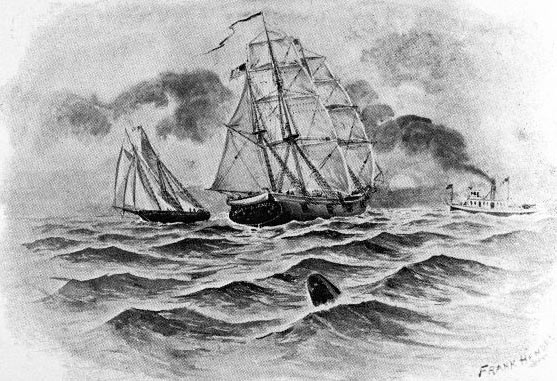
1864 drawing of three vessels
blockading Tampa Bay, the schooner Stonewall, the man-of-war
James L. Davis, and a steamer Sunflower.
Courtesy of Florida Memory: The State Library & Archives
of Florida.
Consequently, U.S. troops took advantage of the
war-weariness of Bay Area residents, especially those with
Union sympathies. Captain Eaton, of the U.S. Ethan Allen
blockading Tampa Bay, estimated that there were about forty
Unionist families in Tampa and, in February 1862, proposed
making Egmont Key into a place of refuge for residents
seeking U.S. protection.
Nine months later, the New York Times reported that a
dozen contrabands and four white refugees occupied the
buildings surrounding the lighthouse, cleared the island’s
ground, and cultivated sweet potatoes. These men and women
recognized that Union forces on the Gulf Coast generally,
and on Egmont Key specifically, represented their best hope
of survival despite the logistical challenges that U.S.
troops faced in supplying refugees and contrabands who
sought their protection.
Egmont Key remained isolated from major engagements, but
the men stationed on or near the island felt the ravages of
one of the Civil War’s most deadly assailants – disease. A
yellow fever epidemic struck the Key in July 1864 and
claimed the lives of sixteen young men – seamen and soldiers
– whose ages ranged from sixteen to thirty-six. Survivors
buried these casualties, along with four others who died
from accidental gunshot wounds as well as from unknown
causes, in a modest cemetery under Egmont Key’s sandy soil,
where they rested until 1909 when the Civil War burials were
reinterred in the National Cemetery in St. Augustine.
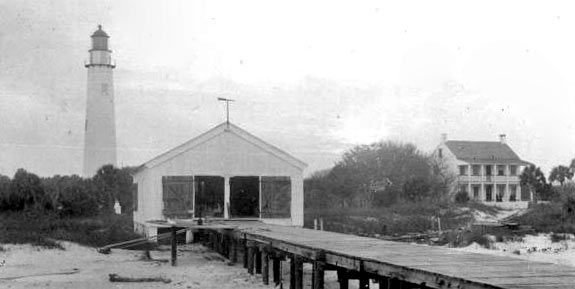
Egmont Key lighthouse & pier, 1910s
Courtesy of Florida Memory: The State Library & Archives
of Florida.
|
|
See separate
page The
Capture of the Salvor and Imprisonment of James McKay. |
|
Records show that Captain McKay shipped 4,016 head of cattle
to Cuba in 1860 but only 2,000 in 1861 after the beginning
of the war. There were no records kept for the remainder of
the war. Imported items like medicine and luxury items like
cloth, coffee, cigars and white flour became rare and were
in high demand in Florida’s small towns. Cuba’s need for
cattle and cotton and Floridians’ desire for luxury items
created a situation of high demand while the naval blockade
caused a severe shortage in supply. These two factors drove
prices up and created the opportunity for huge profits to be
made by anyone who was daring enough to break through the
federal blockade. |
|
River History fact sheet at Hillsborough Water Atlas,
USF.edu
|
|
1862 - February 3
John Jackson is elected as
the 9th mayor of Tampa on February 3, 1862 serving for 19
days, the shortest in Tampa history. This event was a
formality since both the military authorities and
Hillsborough County had assumed the city's activities the
previous year. After his dismissal, Jackson returned to
his general store and remained in Tampa for the remainder
of the Civil War.Mayor after his term as acting Mayor in
place of Hamlin Snell is
up.
The Mayors of Tampa 1856 - 2015,
A project of the City of Tampa, City of Tampa:
Incorporation Timeline |
|
1862 - February 22
Confederate military
authorities suspend the City’s government. Major Thomas
takes charge of the city in the name of the Confederacy;
Mayor John Jackson cedes civil authority to
Major Thomas.
The Mayors of Tampa 1856 - 2015,
A project of the City of Tampa, City of Tampa:
Incorporation Timeline |
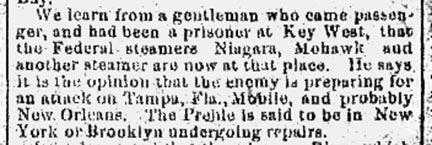
April 19, 1862 -
Savannah Daily Morning news receives word from former Key West
prisoner that enemy is preparing to attack Tampa
|
1862 - April 13 & 14 Fort Brooke threatened, told to
surrender
On April 13, 1862,
Acting Volunteer Lieutenant William B. Eaton, who had begun the blockade,
sent a detachment from his small bark, the USS Beauregard, to
Piney Point (today's Palmetto area), to "shell out a company of
soldiers who were stationed there to watch our movements and
signal to the town." Confederate batteries were located along the
banks of Tampa's main channel, and soldiers were stationed at
various points to keep track of the blockading fleet. Eaton
reported, "A few shells drove them away and a force was landed,
and the barracks, consisting of log huts, were destroyed."
On April 14th, Eaton proceeded
up the harbor, entering the main channel, and anchored off Big
Grassy Island just one and a half miles from Fort Brooke and out
of range of her guns. He sent a boat ashore demanding the
Confederate major R. B. Thomas, who was in command of the fort,
"to unconditionally surrender
the town of Tampa, Fla., together with all munitions of war and
ordinance stores contained therein. If these terms are not
complied with I will give you 24 hours to remove all women and
children to a proper distance and proceed to bombard the town."
Major Robert Brenham
Thomas who commanded Company F, 4 Florida Infantry (“Lafayette
Rangers”) and the Key West Avengers (who became Company K, 7
Florida Infantry) had arrived at Fort Brooke in 1856 and on Feb
10, 1862 was assigned command of the fort. Thomas was a Kentuckian
and the first West Pointer to serve with the Confederacy in Tampa.
There, he met and married a daughter of James McKay.
When Thomas refused to surrender
to the Union threat (but removed the women and children to
safety), the Beauregard withdrew from the bay. There is some question whether
Eaton bombarded the town as he had threatened. Some say he did and the damage
was slight and that he later wrote a letter of apology.
Florida Civil War Blockades: Battling for the Coast By Nick Wynne,
Joe Crankshaw
The Robles Family During the Civil War in Tampa, by Karen
Lucibello
Discovering the Civil War in Florida, by Paul Taylor
|
|
|
|
|
|
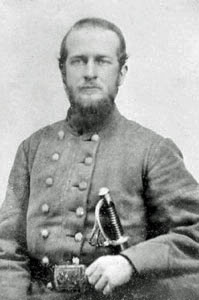 |
Capt. John
Pearson
John William Pearson (January 19, 1808 – September 30,
1864) was an American businessman and a Confederate
Captain during the American Civil War. Pearson was a
successful businessman who established a popular health
resort in Orange Springs near Ocala as well as a hotel,
grist mill and a machine shop. Orange Springs was
a popular destination for tourism in northern Marion
County until the opening of Silver Springs and Ocala by
steamboat after the American Civil War. |
Pearson is best known for forming the
Oklawaha Rangers named after the Ocklawaha River in
Orange Springs. The Oklawaha Rangers were used in the
American Civil War for guerrilla tactics against the
Federal troops throughout North Florida and Central
Florida. Pearson became mortally wounded while leading
Company B of the Ninth Florida Infantry Regiment across
a cornfield at the Battle of Globe Tavern. He resigned
his command as a result of his wounds and died in
Augusta, Georgia while making his way home to Orange
Springs, Florida
Photo & info from Wikipedia |
|
|
1862 - Confederate draft and rebels bushwhacking Unionists
On April 16, 1862, the
Confederate Congress enacted a draft law and in June,
Capt. John Pearson’s
Confederate troops stationed at Fort
Brooke began scouring the woods, looking for deserters and
conscripts. Tampa was nearly deserted, many of its residents
having moved into the country.
Later that year, on Sept. 3, , Capt. J.C. Howell, of the USS
Tahoma, wrote to Secretary of the Navy Gideon Welles, that
three Unionists who had been seeking refuge at Egmont Key,
under protection of the United States, were on the mainland
trying to obtain potatoes, beef, and other supplies from their own farms near Tampa
for the support of themselves and families, when two of them, John and Scott
Whitehurst, while shoving from the shore in their boat, were barbarously
attacked
by Rebel guerrillas. Scott Whitehurst was immediately killed and John Whitehurst
mortally wounded. A third man, named Arnold, is supposed to
have been murdered later in the day. "These guerrillas are scouring the woods,
looking after deserters and conscripts" he wrote. "They rob,
murder, and steal indiscriminately. If the reports of the
refugees are to be credited; Union men they threaten to
hang, and do shoot." |
|
 By James
McKay, Jr. in "Reminiscences
- History of Tampa in the Olden Days" Dec. 18,
1923 By James
McKay, Jr. in "Reminiscences
- History of Tampa in the Olden Days" Dec. 18,
1923
Tampa furnished several companies of men for the army, and
after a year, the inhabitants, all of whom could leave,
moved to the country and the town again began going down
grade. Some few troops were kept as a guard to give notice
of the approach of the enemy -- not for protection of the
place, for this they could not do. Tampa was a dead town at
this time. Only when the enemy gunboats visited the place
and would throw a few shots and shells in the town did the
people show much life.
|
|
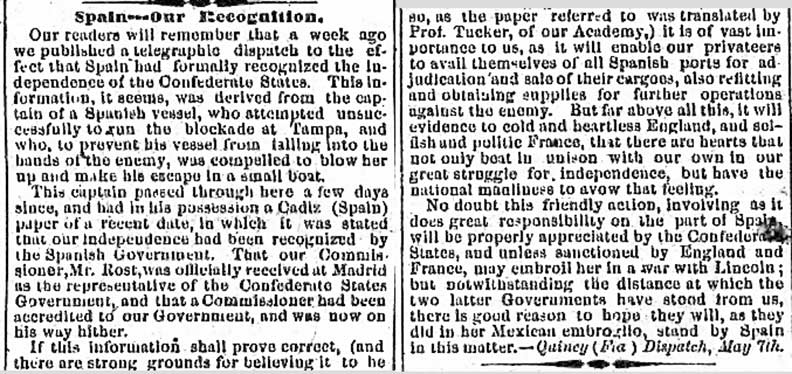
May 10, 1862 - Savannah Daily Morning news - From the May 7 Quincy
Dispatch - Spain recognizes Confederacy
1862 - June 30
- The first assault on Tampa
Major John W. Pearson, who had raised his own company of
volunteers, the Oklawaha Rangers, were ordered in June to
protect the town of Tampa at Ft. Brooke. Pearson replaced Thomas at Fort
Brooke just in time to face the not unexpected arrival of
Union warships into Hillsborough Bay.
On June 30, 1862,
the gunboats,
USS Sagamore and the
Ethan Allen
under the command of Lieutenant Bigelow, came to anchor
broadside to the fort and opened her ports. She sent a
launch bearing twenty-one men carrying a flag of truce.
Pearson took a boat and sixteen men and met the Federal
forces on the bay and rejected the demand for
unconditional surrender, saying “we do not understand the
meaning of the word surrender, there is no such letter in
our book; we don't surrender.”
The Union officers, after
allowing time for the civilians to evacuate the town, began
the shelling of Tampa at 6:00 p.m. and continued it for
one hour. They continued the attack the next morning for two
hours with an 11-inch gun and rifles, inflicted no
significant damage, and then suddenly just sailed away.
Pearson
described the encounter as "a spirited little
engagement."
The Robles Family During the Civil War in Tampa, by Karen
Lucibello
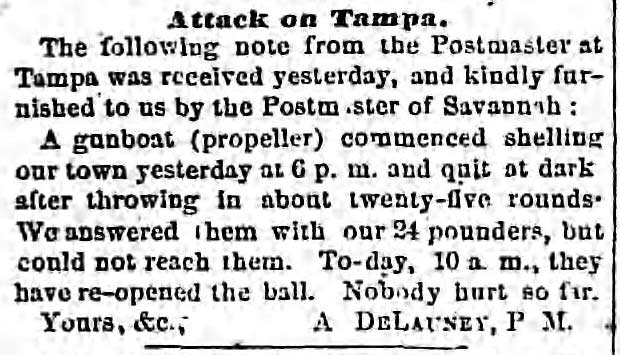
July 12, 1862 Savannah Republican - Letter from Alfonso
DeLaunay, Postmaster, re June 30 & 31 attack
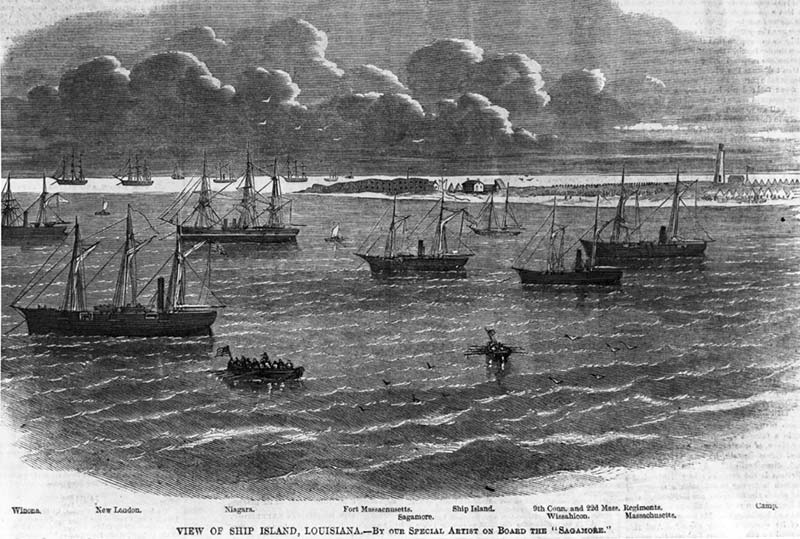
Title: "View of Ship Island,
Louisiana. -- By our Special Artist on Board the 'Sagamore'"
Description: Photo #: NH 59009 View of Ship Island,
Louisiana. By our Special Artist on Board the 'Sagamore'
Line engraving, published in Harper's Weekly, 1862,
depicting several U.S. Navy ships anchored off the Federal
base at Ship Island in early 1862. Ships are (from L to R)
Winona, New London, Niagara, Sagamore, Wissahickon, and
Massachusetts. Other features identified, in the center
and right background, are Fort Massachusetts on Ship
Island, the 9th Connecticut and 22nd Massachusetts
Regiments and a military camp.
U.S. Naval History and Heritage Command Photo.
Catalog #: NH 59009
USS Ethan Allen
The Ethan Allen was built
in 1859 at Boston, Massachusetts; purchased by the Navy 23
August 1861; and commissioned 3 October 1861, Acting
Volunteer Lieutenant W. B. Eaton in command. During her
first wartime cruise, 27 October 1861 to 30 March 1863,
Ethan Allen patrolled in the Gulf of Mexico, capturing
eight prizes, and destroying extensive salt works along
the Florida coast, thus hampering the Confederate war
effort and civilian economy.
Info from Wikipedia
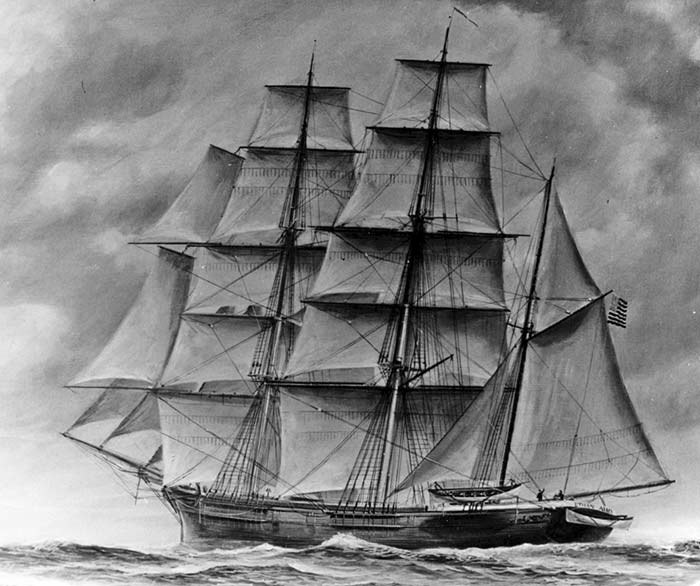
Title: USS ETHAN ALLEN (1861-65)
Caption: Painting by Rear Admiral J.W. Schmidt, USN
(retired). Description: Courtesy of Mrs. Robert H. Hopkins
Catalog #: NH 54113-KN
Photo courtesy of
Naval History and Heritage Command Original Creator:
Artist, Rear Admiral J.W. Schmidt, USN (retired) After
this Year: 1861 Before this Year: 1865 Original Medium:
Painting, BW Photo
|
|
|
|
|
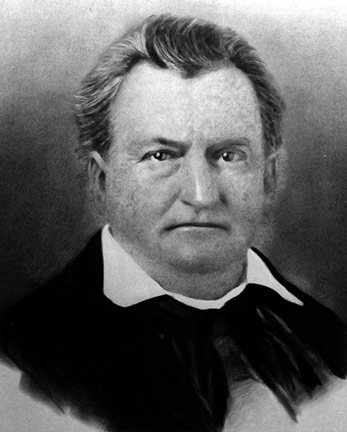 Gov.
John Milton Gov.
John Milton
(1807–1865)
Fifth governor of
Florida
October 7, 1861
to April 1, 1865
John Milton was
born near Louisville, Ga., on April 20, 1807. A descendant
of the English poet John Milton, he practiced law, first in
a number of Georgia and Alabama communities and later in New
Orleans. Before coming to Florida in 1846, Milton allegedly
killed an adversary in a duel. After entering Florida
politics, Milton became a statewide force in the Democratic
party, serving as a presidential elector in 1848 and as a
member of the 1850 House of Representatives. A vigorous
states-righter, Milton encouraged the early secession of
Florida from the Union. As governor, Milton stressed
Florida's ability to serve as an important source of food
and salt for the Confederate war effort. On April 1, 1865,
as the southern cause was collapsing, John Milton shot
himself at "Sylvania," his home near Marianna. In his last
message to the legislature, he had said, "Death would be
preferable to reunion."
Photo from Florida Memory
State Archives
Info from Florida Dept. of State website |
|
1862 -
Magbee's 4-year
Senate term cut short
Magbee suffered a personal
and political blow during the summer of
1862. At Gov. Milton’s request, Attorney General Galbraith issued
an opinion construing the 1861 Florida Confederate constitution approved by that
year’s convention. According to Galbraith, all senators, even
those elected like Magbee to four-year terms in 1860, would have
their terms expire in October 1862. Soon after the word arrived in
South Florida, James D. Green of Manatee County announced his
candidacy. Samuel B. Todd of Tampa entered the contest along with
Gen. Joseph M. Taylor of Hernando County.
Magbee decided not to run, but to contest the results of the
election. Green, who was "a particular friend and correspondent"
of Magbee, soon withdrew, possibly at Magbee’s urging. On
October 6, Todd out-polled Gen. Joseph Taylor in Hillsborough but Taylor
prevailed in the rest of the district and won the election.
1862 - McKay exonerated
When the Grand jury met at Tampa during the fall of 1862, James
McKay was exonerated from his treason charge prosecuted by Magbee the previous year.
The presentment stated that “the prosecution was instigated by
private malice or some not more laudable motive." McKay’s ally,
Gen. Joseph Taylor, was acting solicitor during the proceedings and
Madison Post was foreman of the grand jury.
1862 -
Magbee unseated in the Senate
Magbee was on very shaky ground
when he answered the roll call at Tallahassee on the first day of
the Senate session. The following day Gen. Joseph Taylor was sworn in. Magbee,
along with Sen. P. B. Brokaw, whose situation was identical,
protested, contending that their terms did not expire until two
years later. A Select Committee endorsed the Attorney General’s
July opinion and Taylor was seated.
In October 1862, McKay was elected to the Hillsborough County
commission.
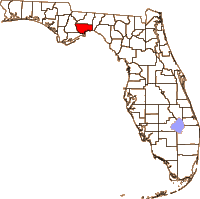 1862
- Magbee leaves Tampa enraged and marries again 1862
- Magbee leaves Tampa enraged and marries again
Magbee was furious. He returned to Tampa, sold his belongings and
moved to Wakulla County (located on the south border of Leon
County, on the Gulf of Mexico.) In the eyes of some, he had
retired in "disgrace."
It had been about 11
months after his first wife Susan died when he married
on
September 7, 1862, in Leon County
to Julia A. Henderson,
a very attractive and
cultured woman and a member of a fine old Leon County family.**
Julia was around 23 years younger than Magbee. Her 1860
census in Wakulla County shows she was the daughter of H. L. and
Nancy P. Henderson, a farming family.
**Julia's description is according to D. B.
McKay.
Magbee waited out the Civil War at this new home in the town of
Newport, Wakulla Co., living the life
of a planter with his seven slaves.
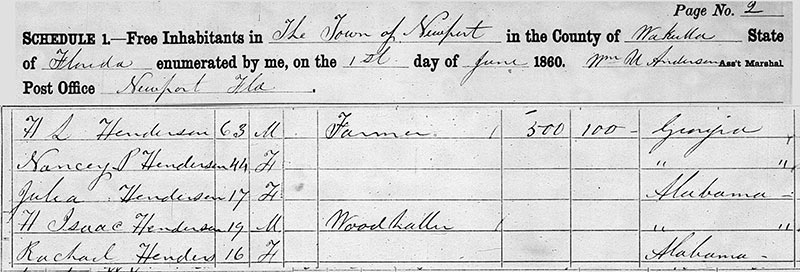
The Henderson family
on the 1860 Census of Wakulla Co., Fla. Julia's father was a
farmer and had real estate valued
at $500, with personal property valued at $100. D.B. McKay's
claim of Julia's family being "...a fine old Leon County family."
appears to be unsubstantiated.

Nov. 13, 1862 Savannah Republican - Oct. 28 letter from Pearson re
Rascally Attack
Ossian Hart and Claiborne Mobley
During the Civil war,
2nd Cavalry Union troops from Cedar Key, led by Gen. Alexander
Asboth, found many closely linked unionist families in the Tampa
area who had been subjected to "social proscription" and
mistreatment by Confederates. Lawyer Ossian B. Hart
protected these unionists from pillage by Union soldiers and acted
as a leader of the unionists when Magbee departed Tampa for
Wakulla County.
Hart was well-known
in Florida, his father was Jacksonville's first storeowner and had
planned the streets of Jacksonville in the 1820s, naming several
of them for his children. Hart took a firm stand against
secession in 1861.
Hart's new friend,
pharmacist Claiborne R. Mobley, a recent resident of Tampa, was
forced to join a local Confederate company.
Mobley, a former Kansas "border ruffian," had arrived in Tampa
during the early part of Civil War and professed allegiance to the
Confederacy. He was captured by Union troops in
October 1863
during the Spanishtown Creek-Scottish Chief incident and
imprisoned at Key West. After the war, Mobley returned to Tampa
where he operated a drug store and practiced law.
By then a
Unionist, he received the appointment of Freedman’s Bureau agent
at Tampa and was counted among the scalawags. Hart avoided
the draft by obtaining a physician's certificate of disability.
All three men, Hart, Magbee and Mobley, would someday serve as
Republican state Judges, and in 1873 Hart would become Florida's
governor.
The Scalawags: Southern Dissenters in the Civil War &Reconstruction, by James Alex Baggett
Learn more about the
controversial Claiborne R. Mobley
at this Word document download.
|
THE CIVIL
WAR IN TAMPA
|
Friday, Nov. 7,
1862
 New York Times
New York Times |
WEST COAST OF FLORIDA.; The Blockade of Tampa Bay
Description of the Coast Wretchedness of the
Inhabitants, A Small Bombardment
From Our Own
Correspondent.
Published: November 17, 1862
UNITED STATES BARK
PURSUIT, BLOCKADING TAMPA BAY, FLA., Friday, Nov. 7,
1862.
This place has been blockaded since last November by
the United States bark Ethan Allen,
assisted of late by the United States schooner
Beauregard, which still remains here. Our ship
came in here the last of September to await supplies
from Key West, when we received orders to remain on
this station and relieve the Ethan Allen,
which was ordered to St. Joseph's Bay on blockading
duty.
The Pursuit left New-York last January, and up to the
time of coming in here, has been allowed a roving
commission, and with considerable success, having
captured several valuable prizes. We are lying up the
bay far enough to guard the entrance to Manatee River,
as well as the passage up to the town of Tampa,
which is thirty-five miles distant.
To the west side of the main ship entrance (north
channel) to this bay is Egmont Key; to the east,
Mullet Key. These keys are small, low, sandy islands,
covered with a rank undergrowth of prairie grass, the
palmetto tree and a few stunted pines. The latter key
is not inhabited. On the extreme sandy point of Egmont
stands the new light-house, one hundred and ten feet
above the level of the sea. The light has not been
lighted since the rebels destroyed the apparatus last
year -- another mark of Southern vandalism. The
keeper's house is a comfortable two-story brick
building, with several out-buildings. They are
occupied at present by some dozen contrabands and four
white refugees, who have escaped from the main land.
The contrabands are engaged in clearing the ground and
planting sweet potatoes.
Some three weeks ago, three wile men, refugees from
Southern tyranny, escaped from Tampa in a small
boat, and came down to us for protection. They are men
of intelligence, and state that they have been using
every means to escape for the last nine months, but
their Union sentiments were so well known that every
attempt proved abortive.
One of them, who formerly belonged to the United
States Army, was put in charge of the guns of a small
sand battery near the town, to prevent him from
escaping, but he was all ready to spike the guns in
case of an attack by our boats. The other two have
been compelled to assist in running sugar from Manatee
River to Tampa, since last July. By pretending
to have changed their feelings and espoused the cause
of the South, they were allowed to load the boat with
empty barrels, as usual, to go for sugar, and leave
alone. On their way down the bay they stopped for
their friend, with whom they had made arrangements
previously, in case they succeeded. When they came
alongside they gave three hearty cheers for liberty
and the Union.
They gave a sad account of things in this part of the
South; that they had to live on corn, sweet potatoes
and fresh meat, without salt enough to cure the
latter, this useful article bringing $20, $30, and
even $40 per bushel, when it can be had.
They say there are 125 soldiers at Tampa, and
another company expected soon to join them; that they
are obstructing the channel, by sinking old hulks, to
prevent the Yankee gunboats from coming up to the
town. They have two small fortifications, mounting ten
old 24-pounders, and are using every means within
their power to be prepared for an attack, which they
are expecting daily.
(Cont. in next column) |
The files of Southern, but more especially Floridian
papers, which they brought, give a still darker
picture of affairs. One hundred and eight thousand men
have deserted from their army since the war began, and
it is with the greatest difficulty they can carry out
the provisions of the late conscription act.
It is almost impossible to subsist the army, the
severe drought having cut off the corn crop at least
one-half. They curse the Nationals most bitterly for
using up all the surplus corn, meat, cattle, as they
advance into their territory. Next after the food
question, clothing the men seems to be the greatest
difficulty, as the cold weather approaches. The
following estimate of a soldier's outfit for the
coming Winter, every article of which is
indispensable, is given by the Chattanooga (Tenn.)
Daily Rebel: Fur cap, $5; one jacket, $25; one pair
pants, $30; one pair shoes, $18; two pair socks,
(wool,) $10; two pair drawers, $8. Total, $96.
We had a little taste of excitement last week. The
schooner Beauregard, commanded by Acting Master
ARTHUR, with Acting Master LAPHAM and a boat's crew
from our vessel, went up the bay, ostensibly to gather
oysters. They arrived at the oyster ground just
before dark, which is above Gadsen's Point, and about
eight miles below Tampa. From there they could
distinguish the tops of houses in the town.
The temptation to have a nearer view was too strong to
be resisted, so they kept on until the lights could be
seen plainly, when they anchored for the night. As
soon as it was light enough in the morning to see,
they found they were about two miles below to town,
and that there was an unusual excitement on shore.
Nearly abreast of them were several companies of
soldiers drawn up in line on the beach, with fixed
bayonets. Near by was a tall flag-staff from which
floated a large secession flag. While our friends were
admiring this parade, gotten up, as they supposed, for
their special benefit, they were awakened to their
position by the report of one of the twenty-fours
from the fortification, and saw the shot strike in the
water at least one mile short of them. This was
followed by another, with like success.
The officers of the schooner, thinking it would be
a breach of etiquette not to return the salute,
trained the 30-pound Parrott rifle, which is a part of
her armament, on the battery, and fired. The shell
struck, and exploded in a small wooden building in the
rear of the fortification, knocking it into splinters.
There was no more firing from the fort. The next shell
struck just in front of the line of soldiers, and,
bursting at the same time, it plowed its way right and
left through them, causing those that were able to
take to the bush in double-quick time.
After dropping some fifteen shells into the fort
and woods, but receiving no response, they concluded
the fun was all up in that vicinity; and, gallantly
dipping the American ensign to the apparently deserted
fort and town, they left for the oyster ground,
where they took on board twenty-five barrels of fine
oysters, and returned to their old anchorage, having
been absent only two days.
I
trust the time is not far distant when we shall have
the opportunity of making them another and still more
effectual visit. PERSONNE |
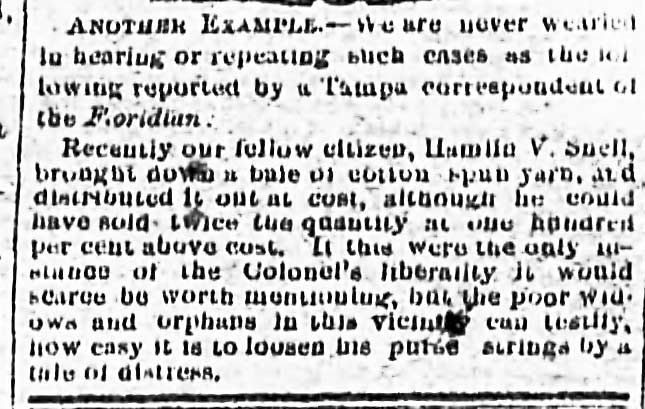
Dec. 3, 1862 Savannah Daily Morning News - Another
Example
Hamlin V. Snell's generosity in selling cotton at cost.
1863 - March
27 - Pearson's Revenge
Angered by
the June 30, 1862 attack and the ramming of a blockade
runner in Tampa Bay by two Federal gunboats, Pearson got
his revenge on March 27, 1863. When the Federal gunboat Pursuit appeared in the harbor, Pearson dispatched
some of his men to Gadsden Point disguised in dresses and
in blackface to lure the sailors ashore. The Union sailors
took the bait and when were in range Pearson’s men emerged
from the woods and opened fire, wounding four sailors and
incensing the Unionists. They again bombarded the town,
but as before little damage was done.
USS Pursuit was a
bark purchased at New York City on 3 September 1861; and was
commissioned 17 December 1861, Acting Volunteer Lt. David
Cate in command. Assigned to the East Gulf Blockading
Squadron, she operated off the Florida coast, with several
cruises to Cuba, during the course of the American Civil
War.
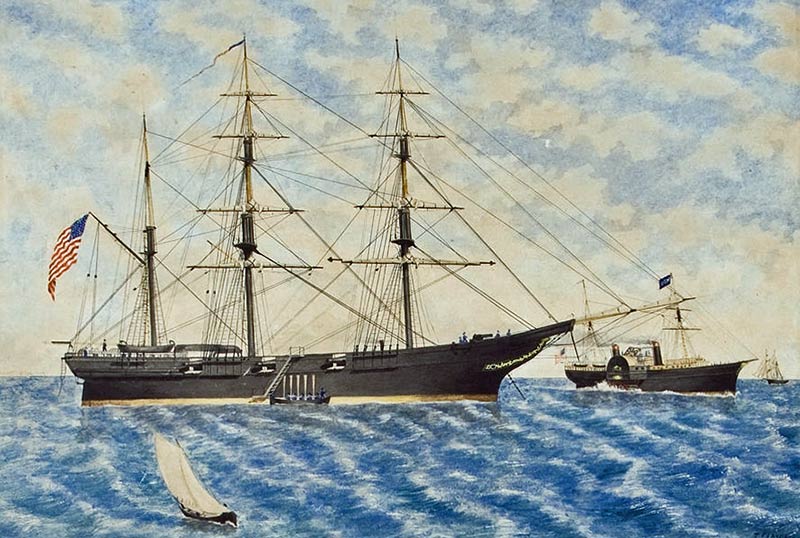
Period watercolor of the USS Pursuit alongside the Federal
troopship Empire City
USS Pursuit watercolor by T Flagler c1863, Heritage Auction
Gallery
Image and info from Wikipedia
1863 -
Oct. 18 - The Hillsborough River Raid and Battle at Ballast Point
The next
bombardment came that October during an invasion by
Commander Semmes. The shelling from the 11-inch Dahlgren
gun (200-pounder) on the
Tahoma and the two 20-pound
Parrot guns, one 12-pound and four 24-pound smooth bores
on the Adela was intense. A shell was said to have
blown the dinner off the table of a Miss Crane. The
bombardment lasted all day and later it was found that 126
shells had been fired at Fort Brooke.
The USS Tahoma was
a Unadilla-class gunboat built by order of the United
States Navy for service during the American Civil War.
Tahoma was used by the Union Navy as a gunboat in support
of the Union Navy blockade of Confederate waterways.
Info from Wikipedia.
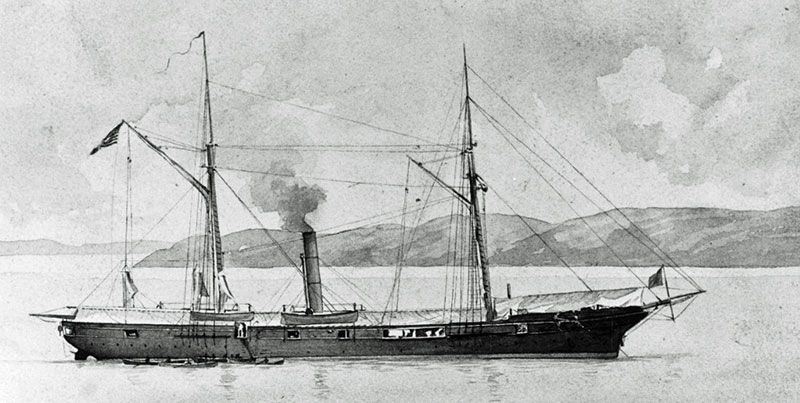
USS Tahoma (1861-1867) Description:
Wash drawing by R.G. Skerrett, 1903, depicting the ship as
she was during the Civil War. Courtesy of the U.S. Navy
Art Collection, Washington, D.C.
Photo from
U.S. Naval History and Heritage Command. Catalog #: NH
57826
The USS Adela
(1862) was a steamer captured by the Union Navy during the
American Civil War. She was used by the Union Navy as a
gunboat in support of the Union Navy blockade of
Confederate waterways.
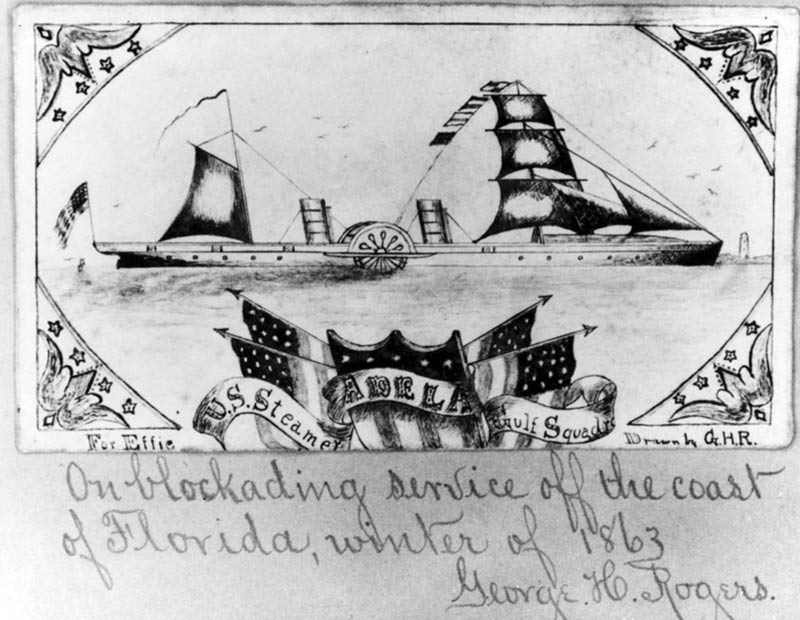
USS Adela Description: (1863-1865) Drawing by George H.
Rogers, depicting the ship on blockading service off the
coast of Florida, winter of 1863. The artist served on
board Adela as a Pharmacist's Mate. Courtesy of Charles
Rodgers Lord.
U.S. Naval History and Heritage Command Photograph.
Catalog #: NH 57250
1863 -
Oct. 18 - The Hillsborough River Raid and Battle at Ballast Point
(continued)
The
shelling was only a diversion, as Semmes had sent 85 Union
troops from the SS Adela and the gunboat USS Tahoma
to move six miles up the Hillsborough River and destroy McKay’s blockade runners,
the Scottish Chief and the Kate Dale.
A Union raiding
party, under Acting Master T.R. Harris, disembarked at
Ballast Point, landing at the current intersection of Gandy
Boulevard and Bayshore Boulevard.
McKay's
ships were at Jean Street Shipyard in preparation
for another supply run through the blockade, along with at
least one other blockade runner, the A.B. Noyes, having
their hulls scraped of barnacles for better speed. They
were loaded with cargo and awaiting the signal to depart
past the blockade. Almost a dozen blockade runners
operated out of Tampa, but McKay was the target of this
raid, presumably for breaking the promise that freed him
from Union captivity a few years earlier.
Acting Rear
Admiral Theodorus Bailey, commanding the East Gulf
Blockading Squadron, wisely chose two local men, Union
sympathizers Henry A. Crane and James H. Thompson, to act as
guides for the raiding party. Crane had moved to
Florida during the Second Seminole War and had served in the
Army during that conflict. When the Civil War broke out,
both men sided with the Union. In late 1862 they joined the
Union Navy, Crane serving as an acting volunteer master's
mate and Thompson as a first-class fireman. They had quickly
been put to use guiding Federal forces throughout central
Florida.
They guided
the Union expedition 14 miles by foot to the Jean
Street Shipyard to destroy McKay’s Ships. The expedition
carried a small boat in case they needed to cross the
river, but ended up hiding it a few miles from their
destination to speed up their walk.
(River Raid
continued after the Crane profile below.)
Henry A. Crane
(c1810-88) Continued from a previous profile:
New Jersey’s Henry A. Crane, a
newspaperman, founded the Tampa Herald in 1852
and was editor of the Florida Peninsular.
During the Third Seminole War,
he served as a lieutenant under Capt. Leroy G.
Lesley. Active in the vigilante or regulator
organization of 1858 were some of Tampa’s leading
citizens, including Henry A. Crane. Crane
advocated secession in 1860 but soon sided with the
Union and left Tampa in 1862, making his way to the
Indian River. Crane's lapse from Unionism
occurred on November 24, 1860 when he signed a
petition of Hillsborough Countians calling for a
convention to consider secession. Among those
attending and signing the petitions were: John
Darling, James Gettis, Reason Duke, James E. Bowden,
Hamlin V Snell, John T Givens and Henry A. Crane.
He joined the U.S. Navy as "acting volunteer
master’s mate" and served until 1864 when he became
a captain in the 2nd Florida Cavalry. On April
2, 1864 Union Capt. Henry A. Crane, formerly of
Tampa, in recommending a commission for James
D. Green, described him as having: "the dash &
daring necessary for a leader in this peculiar kind
of warfare which is different from almost any
other-nothing but skulking Guerrillas to encounter.
During the Civil War he was a
captain, later major in the Second Florida Cavalry,
U. S. Army. After the war, the Republican Crane
settled in Key West where he served as clerk of the
circuit court and as state senator. He was also
editor of the Key West Dispatch and, subsequently,
founder and editor of the Key of the Gulf.
Henry A. Crane's son Henry
Lafayette Crane was a Confederate soldier throughout
the war, later a county judge, and U. S. Commissioner.
Henry Lafayette Crane was born
Sept. 25, 1838 at St. Augustine. He came to Tampa
with his parents in the early 1850s. During the
Civil War he served as Chief Musician of the Fourth
Florida Infantry, CSA. He was captured near Spring
Hill, Tennessee, Dec. 21, 1864, confined at Camp
Chase, Ohio, and released Feb. 18, 1865. Crane and
the Ferris brothers, Josiah and William, had been
members of the Tampa Brass Cornet Band, organized
March 31, 1860, by J. A. Butterfield. The band’s
musical instruments were purchased for $170.11 from
W. G. Ferris and Co. The "S.S. Guards" were the
Sunny South Guards, a Tampa company commanded by
Capt. John T. Lesley. They became Co. K, 4th Florida
Infantry.
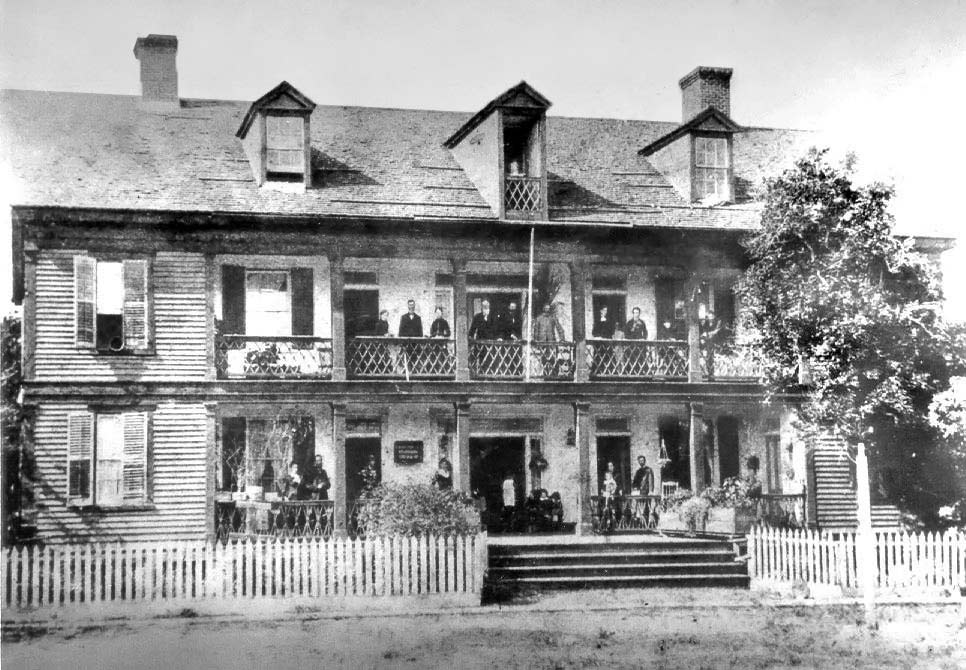
The Orange
Grove Hotel during the 1876-77 winter season.
The Orange Grove Hotel was located near the
present day intersection of Kennedy Blvd. & East St.
See historical marker in downtown Tampa where hotel
was located. The hotel was built in 1859 as the
home of cattleman William B. Hooker, Florida's
pre-Civil War "cattle king". During the Civil War, it
was used as Confederate Headquarters. It is where
Tampa pioneer Joe Robles marched his captive Union
soldiers in the winter of 1863. (See "The Courage of
Joe Robles" below).
In
1866, Hooker converted it into a hotel. Judge Henry L. Crane
and his wife, who operated the hotel in 1876, are
said to be standing on the left side of the second
floor porch. Poet Sidney Lanier has been
identified by contemporaries as the man standing on
the far right side of the second floor porch with his
leg propped on the rail. But D. B. McKay in the Tampa
Tribune, March 6, 1955, said Lanier is standing at the
left end of the first floor veranda. Located at 806
Madison Street.
The original of
this photo was owned by Mrs. Samuel E. (Mary Hooker)
Hope, later Mrs. Clara (Hope) Baggett and then by Mr.
and Mrs. L.E. Vinson of Tarpon Springs.
The
large image used above is courtesy of William LaMartin,
with ultimate source being the
Florida State Archives Memory collection.
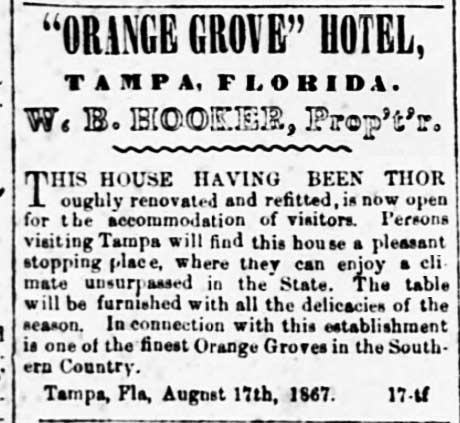
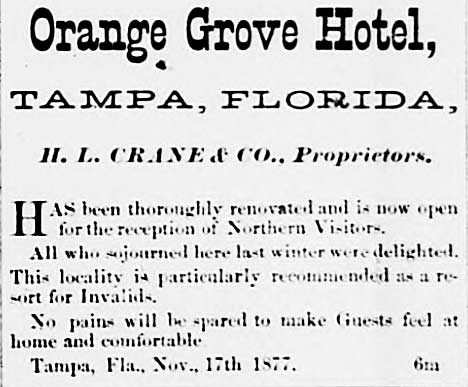
Ads in the
Florida Peninsular
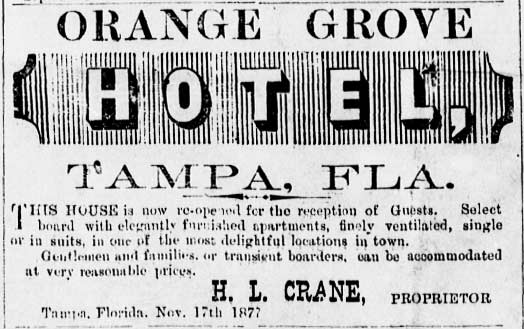
Ad in the 1882 "Key of the Gulf"
Key West newspaper
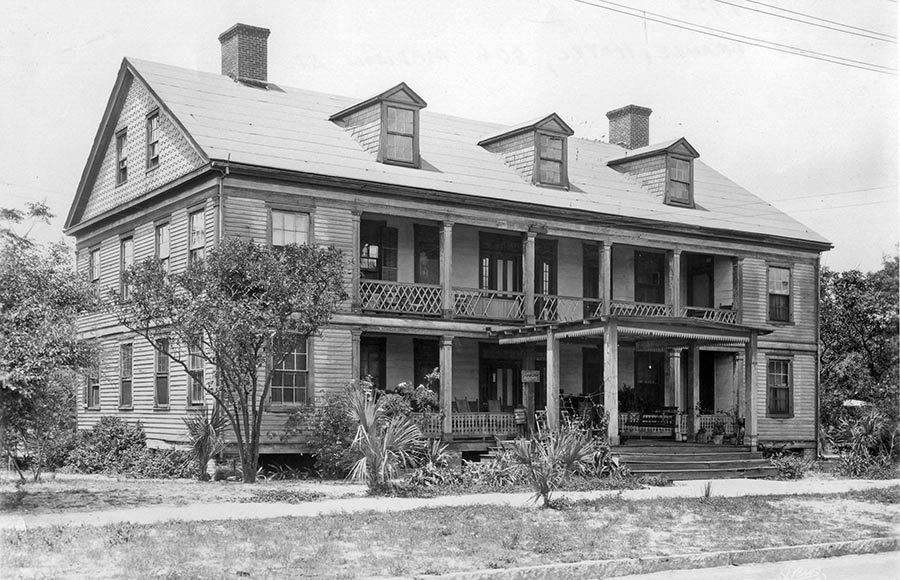
|
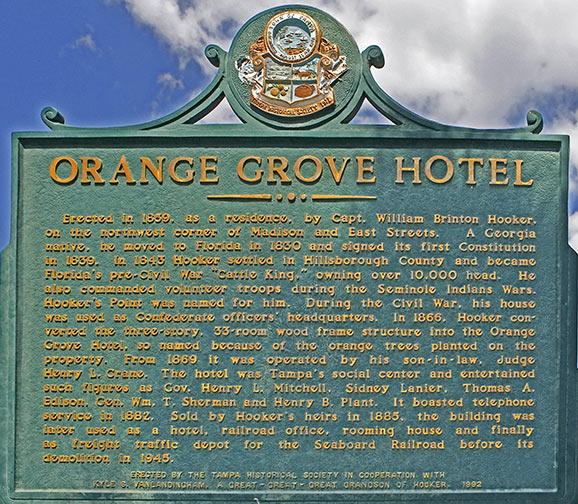 |
|
Click to enlarge the marker
See the fine
print at the bottom of the marker:
Erected by the
Tampa Historical Society in cooperation
with Kyle S. VanLandingham, a
great-great-great-grandson of (William B. ) Hooker. |
Orange Grove Hotel, 1924
Burgert Brothers photo courtesy of the USF Digital
Collection
Same photo at the Florida Memory
collection includes:
Note from sleeve: Poet Sidney
Lanier stayed here during his visit to Tampa (Dec.
1876 - April 1877) and wrote 11 poems, including the
famous "Tampa Robins".
| A famous visitor came to Tampa in 1876. The
celebrity was Sidney Lanier, noted poet
of the South, who arrived with Mrs. Lanier on
December 21.
At first he was not much impressed with Tampa
and in a letter home described it as "the most
forlorn collection of one-story houses
imaginable." Mr. and Mrs. Lanier stopped at the
Orange Grove Hotel, the former home of William
B. Hooker which had been converted into a hotel
and was being operated by Hooker's son-in-law
and daughter, Mr. and Mrs. Henry L. Crane.
Lanier described the hotel as "a large
three-story house with many odd nooks and
corners, altogether clean and comfortable in
appearance, and surrounded by orange trees in
full fruit."
Lanier came to Tampa primarily to obtain data
for a Florida guide book he was then writing and
expected to remain only a short time. But he
learned to like the town so much that he stayed
three months. |
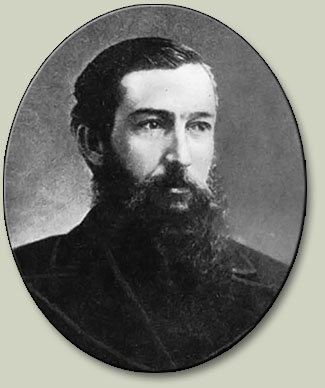 |
|
Sidney
Lanier photo from "Literary Hearthstones
of Dixie by Pickett, La Salle Corbell,
1848-1931 at Project Gutenberg,
Internet Archive.org |
In a letter to a northern friend he
rhapsodized: "What would I not give to
transport you from your northern sorrows
instantly into the midst of the green leaves,
the gold oranges, the glitter of great and
tranquil waters, the liberal friendship of the
sun, the heavenly conversation of the robins,
and mockingbirds, and larks, which fill my
days with delight."
While in Tampa, Lanier wrote eleven poems
including Tampa Robins, The Mockingbird,
The Masters, and A Ballad of the Trees.
Despite his love for Tampa, Lanier never
returned. His failing health prevented him
from again undertaking the long, hard journey,
the trip from Philadelphia having required
eleven days. He had spent four days on trains,
four days on steamers, and three days in
layovers at Danville, Va., Brunswick, Ga.,
Fernandina and Cedar Keys. He had traveled
from Cedar Keys to Tampa on the steamer Valley
City, of which Capt. James McKay, Jr., was
master.
Tampa, A History of the City, etc by Karl H. Grismer
|
|
1863 -
Oct. 18 - The Hillsborough River Raid and Battle at Ballast Point
(continued)
Somehow,
the expedition ended up on the wrong bank of the river.
Since they had previously left their boat behind, they had
no boat to cross the river. The surprised and equally
disorganized sleeping crew of the Scottish Chief ,
however, actually sent a boat for two Union officers, and
a hand full of the Union soldiers that were calling to
them from the other bank. The Scottish Chief’s crew was
ambushed, and the landing party removed 156 bales of
cotton from the Scottish Chief and 11 bales from the Kate
Dale before they set them aflame.
McKay and
his Captain of the Scottish Chief, and two crewmen
escaped, but five other crewmen were captured. The captain
and the two crewmen that escaped ran to Tampa and alerted
the town and the Fort of the attack. Another boat at
the Shipyard (name unknown) was also destroyed by the
Union soldiers. The “A.B. Noyes” escaped upriver, near to
what is now Lowry Park, only to run aground and be burned
by its own crew to prevent it from being captured and used
by the Union. Had the Captain and two crewmen of the
Scottish Chief not escaped, the Union expedition would
have undoubtedly destroyed the shipyard, but aware that
the fort would quickly be alerted, and with their primary
mission now accomplished, the expedition quickly moved
back south toward their rendezvous point of Ballast Point,
some 14 miles away.
1863 - Oct. 18 - The Battle at Ballast Point
On the way
down to Ballast point by land, Harris's Union forces were
surprised by a detachment from the garrison; the 2nd Florida
Infantry Battalion. A brief but sharp exchange resulted in a
few casualties before the Union troops returned to Ballast
Point.
The Union
sailors finally reached the shore at Ballast Point (near
current day intersection of Bayshore Blvd and Gandy Blvd)
and posted lines of lookouts while they waited to
board their ships. A short time later, Harris received word
that a party of Rebel cavalry was hiding the woods. A
company of Rebel infantry was also reportedly advancing.
When he
learned of the enemy's presence, Harris ordered his party to
prepare for a fight in case they were attacked before the
boats arrived. At 10 a.m. from aboard Adela, Lieutenant
Stodder saw some of his sailors on the beach. He quickly
signaled the Tahoma, and boats from both ships were sent to
recover the men.
Harris
ordered all but about 20 men, including officers, to depart.
As the departure began, Confederates in the woods opened
fire on the them. The Rebels brought a weapon manufactured
in Tampa from a bored-out engine shaft and used it to blast
buckshot at the sailors.
Harris's
raiders were met by not just local militia with homemade
weapons, but by 40 armed Confederate soldiers, under the
command of General Bragg, who just happened to be in Tampa
at that time as part of an expedition to protect a cattle
drive leaving Tampa to supply the Confederate front.
Meanwhile,
gunners aboard the Adela caught glimpses of the Confederates
hiding in the tree line, upon which they opened fire so as
to cover the landing party's escape. Admiral Bailey later
reported that while most of the landing party, along with
seven prisoners, headed for the boats in an orderly manner,
the rear guard spread out and returned the Confederates'
fire "energetically and with great coolness and bravery."
But one young Confederate, Dick Robles, noted that some of
the Federals "threw away their heavy guns" so they could get
away more quickly.
The Confederate cavalry unit,
the Oklawaha Rangers, also caught up with the Union raiders,
and a full engagement ensued. The union soldiers came under
direct fire as they boarded their dinghies in a tactical
retreat.
For about 20
minutes, Harris and the rear guard were under heavy fire
until the landing boats arrived and the acting master gave
the command to pull out with the wounded. As the last of the
sailors waded out to their boats, the Confederates continued
their assault. One sailor was killed in the water while six
more were captured. Of those captured, two were severely
wounded; one of them died the following day at a hospital in
Tampa.
By 2 p.m.,
all the boats had returned to the Adela with the wounded. As
the two gunboats were preparing to leave Hillsborough Bay,
Semmes sent another raiding party to Frazier's Beach at the
head of the bay (near the east end of present-day
Courtney-Campbell Causeway), where it destroyed a large salt
works factory owned by McKay. In operation since early in
the war, the works was equipped with large boilers, giant
kettles, vats and barrels. Losing this facility was a
devastating blow to the people of Tampa, as salt from the
works was locally used to preserve food.
1863 - Oct. 19 - The aftermath
|
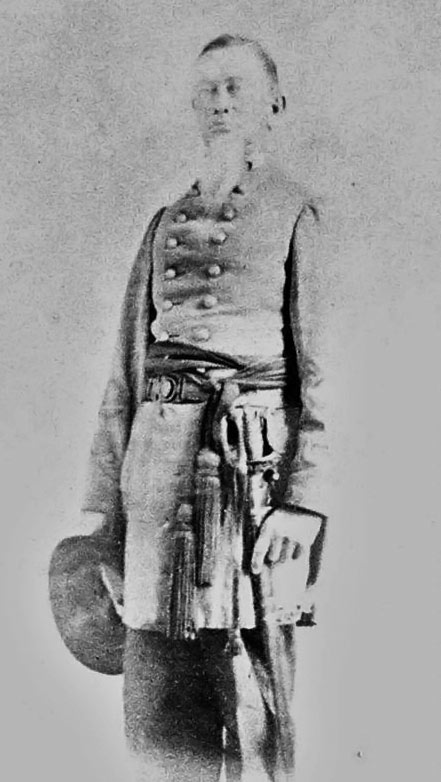 |
|
|
Dr.
John D. Westcott (1807-1889), Surveyor General of
Florida (1855) Pres. Florida canal company
(1881-1889). Courtesy, Museum of the Confederacy,
Richmond, Va. (Carte d’ visite).
From Florida's Big Dig |
|
Captain John Westcott of
Company A, 2nd Florida Infantry Battalion, who was a recent
arrival in the Tampa area, had taken command of Confederate
forces at Fort Brooke on October 14, 1863, just before the
Union river raid. The next
day after the raid, Semmes and Westcott met under a flag of truce to
discuss the status of the prisoners. No decision was made
about the them, and negotiations continued for more than a
month as noncombatants were exchanged.
The Federals
considered the mission a success, since the goal of
destroying McKay's two steamers and their cargo had been
achieved. Five Southern boatmen and two militiamen were
captured, six killed and a significant number wounded. The
Federals also paid a price. Three sailors; Joseph O'Donnell,
James Worrall and John B. Roddy; were killed, 10 others were
wounded and five others were taken prisoner.
Confederate
commander Westcott also considered the engagement at Ballast
Point a Southern victory. He reported that before the
Federals returned to their boats, "they were badly
whipped.... If I had more men I could have captured the
whole concern."
By
the time the story got to the Savannah Republican, from the
Tallahassee Floridian by report from someone in Gainesville,
it was a "rout" by Westcott, capturing 50 prisoners (instead
of 5).
|
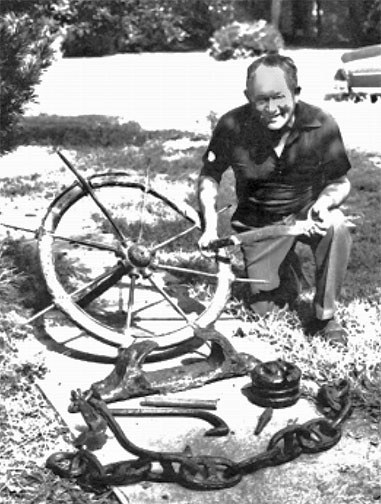 |
|
SCOTTISH CHIEF
RELICS
Calvin “Pop” Taylor, Tampa diver and historic
preservationist, is shown with the helm of the
Scottish Chief and other artifacts which he recovered
from the Hillsborough River. (Photo by Tony Pizzo)
|
After the
loss of his ships, McKay accepted an assignment as head of
the Fifth Commissary District for the Confederacy and
continued to provide the Confederate Army with cattle for
meat, tallow and hides. At the request of Federal Brig. Gen.
Daniel P. Woodbury, Henry A. Crane was transferred to the
U.S. Army. Admiral Bailey wrote a letter to Woodbury
stating that Crane was "well known and popular among the
people of lower Florida, and will, no doubt, be useful in
recruiting."
The
remains of the Kate Dale are sunk near the west side of the
Jean St. Shipyard. The Scottish Chief remained afloat after
it burned, and it was towed back to Tampa by its owner,
stripped of its fittings and furnishings, and the rest destroyed. The
remains of the A.B. Noyes lies in the river just up from
Lowry Park and can sometimes still be seen at low tide. Its
sighting is often included in the Nature Boat Tour from
Lowry Park Zoo.
The Hillsborough River Raid and Battle of Ballast Point
by Lewis Zerfas, America's Civil War magazine
Long-Lost Ship May Surrender Civil War Secrets
Scottish Chief, The Pride of Tampa Bay
McKay Historic Marker
Civil War Monument Courthouse
Jean Street Shipyard**
The Robles Family During the Civil War in Tampa, by Karen
Lucibello
The American Battlefield Protection Program
Read more
about the wreckage of the Scottish Chief in this 2009
article:
Divers Survey Wreckage of Civil War-Era Boat
**Jean St. Shipyard's account of the River Raid (which cites
the Tampa Bay History Center as their source, see below) has
James McKay hiding and watching in horror as his
blockade-running ships burned. Others say he escaped
with the others and alerted Ft. Brooke about the attack.
They also state that "both sides incurred heavy casualties,"
but most sources say the number of casualties, other than
the few which occurred as the raiding party made its escape
to Ballast Point, are unknown.
From Jean St. Shipyard website:
We give our thanks to the Tampa History Center for the
use of their research materials and records, and we
graciously give our thanks for the many neighbors and
residents of Tampa who provided us with the pictures
and stories to reconstruct the history of Jean Street
Shipyard for this Website. We would be very happy to
hear from anybody who can provide further pictures and
stories of interest to Tampa. Please e-mail us at
history@jeanstreetshipyard.com
Thank you,
John W. Brotherton,
Owner and Operator of Jean Street Shipyard, Inc. |
The Courage of Joseph Robles
|
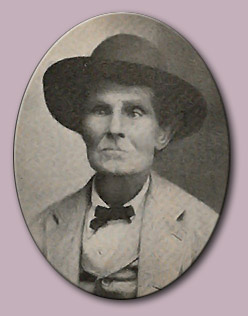 |
|
The first
avocado trees on Florida's west coast were planted by
Joe Robles.
|
There is no
doubt, however, that in the fall of 1864, Joseph Robles
exhibited his own brand of courage and patriotism. He was on
guard duty at the salt works owned by Captain James McKay at
Frazier’s Beach at the head of Old Tampa Bay. When Robles
saw a Union landing party, the USS Nita and the USS Hendrick
Hudson approaching and anchor at approximately where the Gandy
Bridge is now, he must have known that the crew of eighteen
to twenty men entering the launch were coming to check
whether the works had been rebuilt after Union forces
destroyed it a year earlier. Ten or twelve of them
came ashore to do another wrecking job.
Robles
concealed himself in one of the old abandoned steam boilers
used to evaporate the salt water which had been destroyed on
the previous raid. When the landing party started up the
beach he “cut loose with his heavy caliber double-barreled
rifle and brought down two and wounded several others with
the first discharge.” The men in the boat backed off the
beach stranding the shore party.
Robles told
the eight survivors to drop their weapons and lined them up
for the march back to the commander of the Home Guards
stationed in the Orange Grove Hotel in Tampa. All the while
during the march his muzzle-loading rifle was empty, but his
captives didn’t know that and went along passively.
In his
“Pioneer Family” column, D. B. McKay recalled seeing that
old boiler out on the beach when he was a young man on
hunting and fishing expeditions in the area.
On November
24, 1948 reporter Jim Powell of the Tampa Sunday Tribune
wrote an article, “Tampa Confederate Vet, Nearing 100, Takes
Life Easily.” In it Joseph Robles summed up some of his
feelings
“War is a bad thing, Sherman was right when he
said ‘war is hell. ’ There has always been war. It will
always be. There’ll never, in my opinion, be peace as long
as there’s a man living.”
About himself he reflected,
“My
life hasn’t been perfect, as no man’s has, but I don’t
figure I will leave the world any worse than I found it."
See Joe Robles feature at TampaPix.com
The Robles Family During the Civil War in Tampa, by Karen
Lucibello
Salt works historic marker from waymarking.com |
1863 - Dec. 24 - USS Tahoma fires on Ft. Brooke again
A later
bombardment took place by the Tahoma on December 24, 1863.
On Christmas Eve, Tampans were given another reminder of
the Union’s presence and a warning not to interfere with
the Union forces around Fort Myers. The warship USS Tahoma
anchored off Fort Brooke and fired off one shell just
before midnight. The next morning after fine-tuning its
trajectory it bombarded the fort and the town at two hour
intervals.
|
 Many deserters from the army and some from the lower part of
south Florida below Fort Meade, with the notorious Jim
Green, located at Fort Myers, and increasing in such numbers
the Federal government organized them into companies. There
were also negro soldiers with this command. Many deserters from the army and some from the lower part of
south Florida below Fort Meade, with the notorious Jim
Green, located at Fort Myers, and increasing in such numbers
the Federal government organized them into companies. There
were also negro soldiers with this command.
These deserters made raids in the interior, taking cattle
owned by loyal southerners and destroying homes to such an
extent, the authorities sent Colonel Munnerlyn to this
section, directing him to organize the citizens and all home
companies into an organization under the name of Munnerlyn’s
battalion, for the protection of south Florida, with
headquarters at Brooksville.
During the summer of 1864 a body of these deserters
numbering about 90 under Jim Green, well armed and equipped,
marched overland from Fort Myers in direction of Fort Meade,
with the purpose of destroying all houses in that locality,
but they were discovered when within 15 miles of their
destination. We met them with some 25 men and had a
fight, they killing one of our best men, Jim Lanier. However
we stopped them from carrying out their foul intentions and
turned them down the Peace Creek swamp, they making their
escape during the night.
by James
McKay, Jr. in "Reminiscences
- History of Tampa in the Olden Days" Dec. 18,
1923
|
1864 - May
5 - Fort Brooke and Tampa fall to Union forces
| |
The Union ships James L. Davis, Sunflower and
Honduras
James L. Davis (Bark: t.
461; l. 133'; b. 30'7"; dr. 12'; also called J. L.
Davis), a wooden sailing vessel, was purchased at
Philadelphia 29 September 1861; and commissioned 30
December, Acting Volunteer Lieutenant Joseph Winn in
command. At the beginning of 1864 the
James L. Davis was ordered to Tampa Bay where
she served until fall. On 4 May 1864 she joined
Sunflower and
Honduras in landing Army troops at Tampa and
in providing men for a naval, landing party which
helped to capture the town 6 May. During the operation
the three ships cooperated in capturing
blockade-running sloop Neptune with a cargo of cotton.
In July and August, James L. Davis participated in a
series of successful boat expeditions which destroyed
salt works, a large saw and grist mill, and a sugar
mill belonging to Jefferson Davis.
The first Sunflower, (ScStr: t. 294;
l. 104'5"; b. 20'9"; dr. 12') a screw gunboat
purchased at Boston, Mass., on 2 May 1863, was
commissioned on 29 April 1863, Acting Master Edward
Sice in command. Sunflower was assigned to the East
Gulf Blockading Squadron and arrived at Key West in
mid-May 1863. On Christmas Eve 1863, she
captured blockade runner Hancock near the
lighthouse at Tampa Bay with a cargo of salt
and borax. Sunflower remained on patrol during
1864 and, on 24 March, captured sloop Josephine
in Sarasota Sound. Josephine was en
route from Tampa to Havana with a cargo
of cotton when she was intercepted. Sunflower,
with Honduras and I. L. Adams
[sic-should be J. L Davis], supported the capture of
Tampa, Fla., in a combined operation from 4 to
7 May. These Union ships transported Northern soldiers
to Tampa and also provided naval landing
parties which participated in the assault. On the 6th,
the three ships captured sloop Neptune which
was carrying a cargo of cotton, when she attempted to
run the blockade On 2 June, Sunflower landed
three armed boats to destroy salt works at
Tampa Bay.
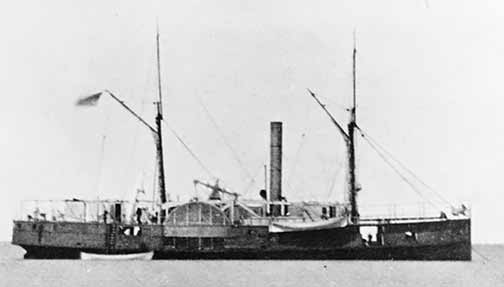
USS Honduras at anchor in Key West, 17
January 1865. Scott De Wolf Collection. Courtesy of
Mrs. Ida M. Harris, Sunnyrest, Port Washington, New
York, 1932.
From Naval History and Heritage Command.
Honduras, (Side wheel steamer: 376
tons; length 150 feet; beam 27 feet; depth of hold 10
feet; speed 12 knots; armament 2 12-pounder rifled
guns) was built in 1861 at New York and purchased from
her owner, Simeon Ackerman, 31 July 1863. Converted to
Navy use, she commissioned at New York Navy Yard 8
September 1863, Acting Lieutenant T. Stites in
command. Assigned as a supply boat and dispatch
steamer with the East Gulf Blockading Squadron,
Honduras sailed for Key West soon after commissioning.
She carried mail and dispatches, and in addition
served on the blockade which so effectively strangled
southern commerce and strength. She captured British
blockade-runner Mail in the Gulf of Mexico 15 October
1863, and early the next year supported a joint
operation at the mouth of the Caloosahatchee River.
Honduras carried troops to the mouth of the river
and disembarked them 4 January 1864. In addition to
her regular dispatch duties, the steamer also
participated in the capture of Tampa, Fla., by
joint expedition, 4-7 May 1864. Honduras, with
Sunflower and James L. Davis, carried
General Woodbury and his troops to Tampa
and provided a naval landing party which joined in the
assault. During the successful operation the ships
also captured blockade-running sloop Neptune 6 May.
Info from Naval History
and Heritage Command
|
On May 5, 1864,
Tampa and Ft. Brooke fell to the Union forces.
Commanding Gen. Woodbury landed troops south and east of
Tampa, surrounding and capturing it by surprise. Troops from
the James Davis, Honduras and Sunflower, along with Navy
personnel, comprised of elements of the 2nd U.S. Colored
Regiment, 2nd Florida cavalry, U.S. sailors and Florida
Union (irregular troops) quickly overtook the town and the
fort without a fight. The town of Tampa was relatively
empty at the time because most of the men between the ages
of eighteen and forty-five were away raiding Unionist farms
or rounding up cattle. Darwin Givens, who was 5-years
old at the time, went screaming home through the streets,
"The devils are coming!"
The Federal troops destroyed the fort and scattered the
larger old cannon along with most of the fort's armaments on
the banks of the Hillsborough River and hauled off many of
the smaller cannon. They arrested about 40 citizens,
damaged or destroyed buildings and machine shops, and even
plundered ritual items from the Masonic Hall. About a year
later, those items were returned to Tampa when they were
found by Union officers in Key West. The Federals left after
Tampa was rendered
defenseless and no longer a threat to the North.
Not finding enough justification to stay, after they threw most of
the fort's armaments into the Hillsborough River and took much
of the city's remaining food and supplies, they left after
three days.
When Westcott and his Confederate soldiers returned, they
immediately saw the damage done to the fort.
Westcott decided that the outpost was no longer worth
manning and departed after only a few days. On May 15, a
Federal force commanded by Captain D.B. Westbury came back
to Tampa and stayed about a month. The Federals
soon left after also deciding that the town had no further
military importance.
|
 They again made a raid into Tampa, capturing the town.
General Woodbury in command and some 400 deserters and negro
soldiers holding the town for two days, after taking what
property suited them hurriedly left, hearing that Dickinson
and his men were advancing on the place to attack it. They again made a raid into Tampa, capturing the town.
General Woodbury in command and some 400 deserters and negro
soldiers holding the town for two days, after taking what
property suited them hurriedly left, hearing that Dickinson
and his men were advancing on the place to attack it.
I was at Fort Meade with 55 men, organizing some 1,200 head
cattle, to forward to the army of Tennessee, when I received
the news of the capture of Tampa at 2 o’clock that
afternoon. I left with 35 men for that place, reaching
within two miles of the town at 11 o’clock the same night,
when I obtained information as to the force that occupied
the town.
Immediately upon receipt of news of the capture of Tampa,
couriers were dispatched calling all citizens to report to
the Six Mile creek, as quickly as possible, which they did
and by noon of the next day we had about 75 men and boys.
The morning after my arrival near Tampa, I sent a flag of
truce into the town by Gideon Zipperer and another man, two
of the bravest and best men I had with me, requesting that
my wife and child be permitted to leave the town with these
men, as I would attack the town within 24 hours. Mr.
Zipperer is now living below Bartow on his magnificent home
and orange grove. The Federals declined to permit either the
men or my wife to leave the town and held them until they
evacuated the place, taking some 60 bales of cotton that my
father owned.
By James
McKay, Jr. in "Reminiscences
- History of Tampa in the Olden Days" Dec. 18,
1923
|
|
THE CANNON** OF
FT. BROOKE AT PLANT PARK
In 1891 while constructing the Tampa Bay Hotel, H.B. Plant
was
credited with saving these cannon by bringing them to
the grounds of the Tampa Bay Hotel from Ft. Brooke and including them in a "Childrens Fort" play
area.
Originally part
of a battery of 3, mounted on Barbette Carriages and placed
in the year 1861 near the northeast corner of the mouth of
the Hillsborough River, these 24-pound shot sized cannon were
used to defend Tampa and Fort Brooke during the Civil War.
When Tampa fell to Union forces, the 24 pounders were disabled and their mounts destroyed.
Two smaller 6 pound shot size cannon were carried away.
**Cannon is both singular
and plural. |
|
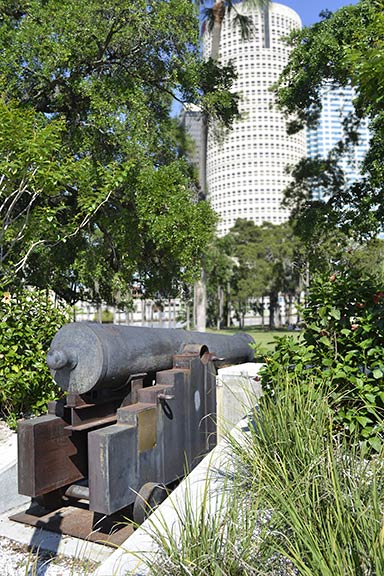 |
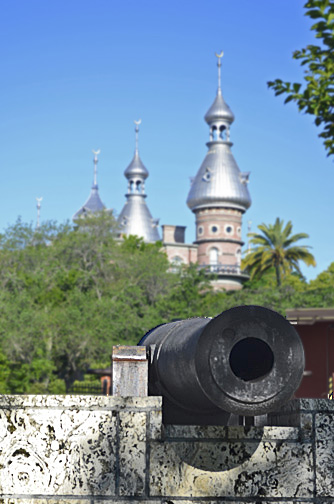 |
|
Cannon photos
by TampaPix
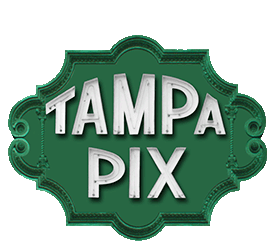 Plant Park, April 2, 2011
Plant Park, April 2, 2011 |
|
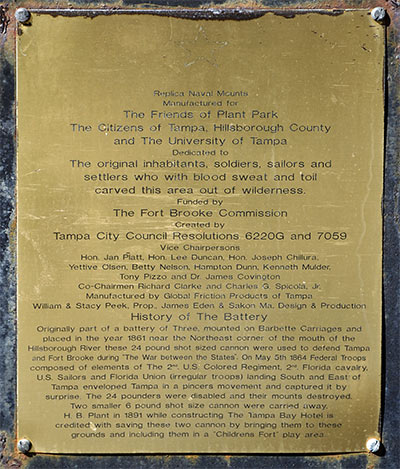 |
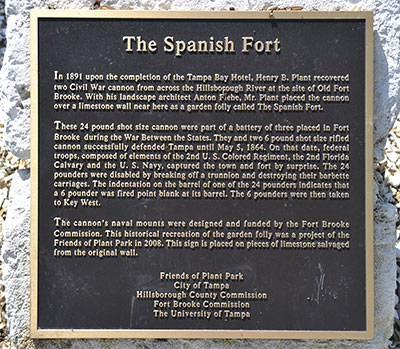 |
|
Click the
plaques to see them larger |
|
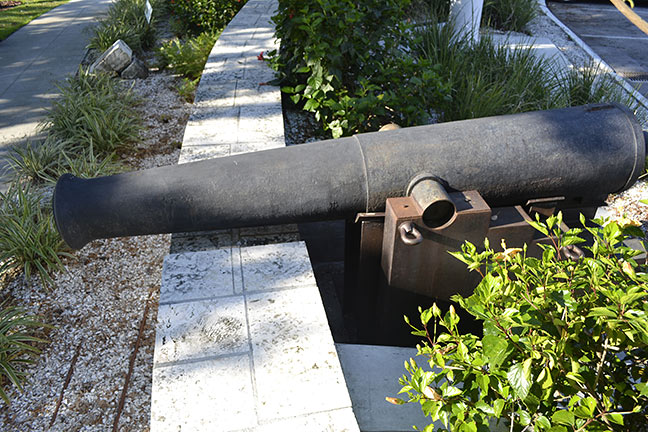 |
| |
|
|
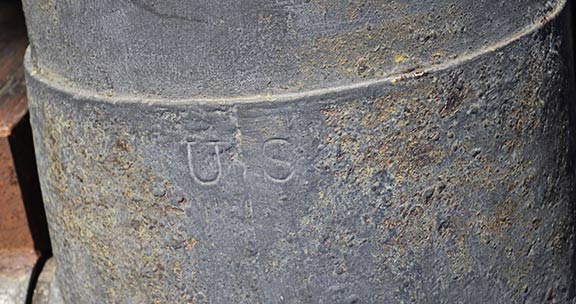 |
| |
|
|
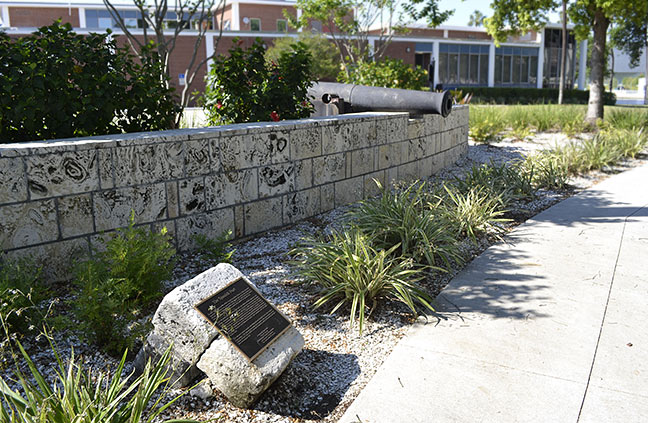 |
| |
|
|
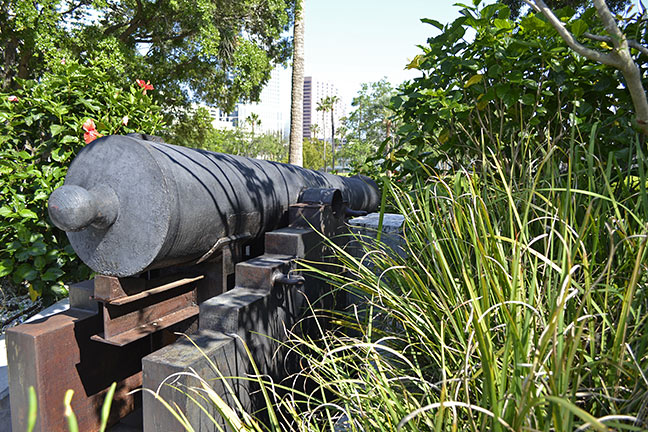 |
| |
|
|
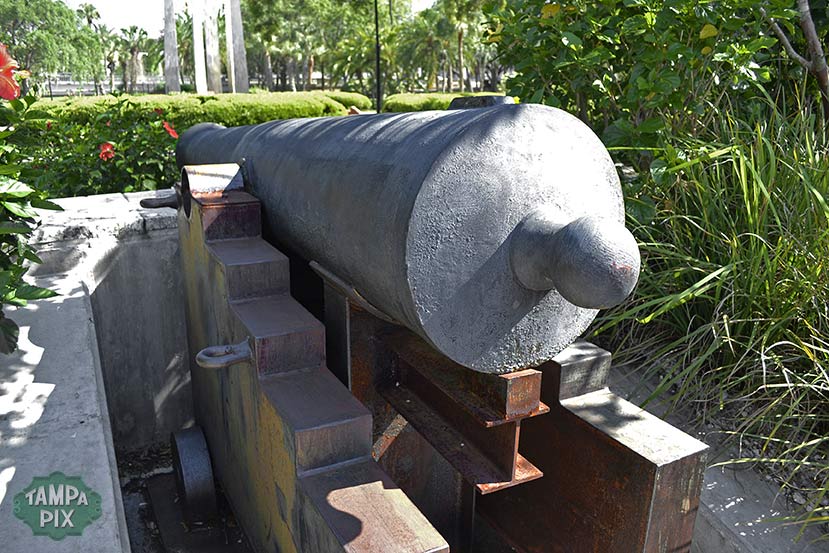
|
Darwin Branch Givens (1858 - 1942) was a young boy when
Union forces arrived. As a young child, he alerted Tampa of
the invading Yankee soldiers with the cry "the devils are
coming." For his bravery, he was actually granted a
Confederate soldier’s pension long after the war.
|
 I had placed pickets on all roads leading out of Tampa, with
orders to halt all passers, no matter who they were. The
picket force was composed of six men. At 12 o’clock the
night of the day the federals evacuated Tampa, six men came
riding up the road from the direction of Tampa and although
the guard heard them talking before getting abreast of their
position they were permitted to pass without challenging. I
was notified two hours afterwards, when I immediately
started six men after them, but it was too late, for they
had some 10 or 12 miles the start of our men. The deserters
proved to be Jim Green and five of his followers. I had placed pickets on all roads leading out of Tampa, with
orders to halt all passers, no matter who they were. The
picket force was composed of six men. At 12 o’clock the
night of the day the federals evacuated Tampa, six men came
riding up the road from the direction of Tampa and although
the guard heard them talking before getting abreast of their
position they were permitted to pass without challenging. I
was notified two hours afterwards, when I immediately
started six men after them, but it was too late, for they
had some 10 or 12 miles the start of our men. The deserters
proved to be Jim Green and five of his followers.
by James
McKay, Jr. in "Reminiscences
- History of Tampa in the Olden Days" Dec. 18,
1923
|
Along with many other ships that fought in the Civil War,
Adela and Tahoma were decommissioned after
the war and auctioned off by the Navy in New York. Adela
brought $21,000 on November 30, 1865, and Tahoma was
sold for $3,000 on October 1, 1867.
Tampa - An Intimate History: Tampa Trivia
Hardcore Confederates
The blasé
attitude towards the bombardments adopted by Robles and
the citizens of Tampa was noted by a New York Herald
reporter: “Some of the rebels would dodge behind the trees
when the shells were fired and after they had exploded
would come out again evidently much pleased with the
fireworks.”
Despite
their brave fronts, Tampa’s wives, mothers, sisters and
sweethearts not only faced the loss of their beloved men
from war and disease in far off places, they faced
depravation at home. Women’s lives in Tampa were greatly
affected by the widespread shortages brought about by the
blockade. Luxuries and often the basic necessities of life
were curtailed. Candles were used sparingly because of the
shortage of tallow. Clothing became scarce. New dresses
were unavailable due to the cost of cotton. Some women
made do with hats made from palmetto fronds. Shoes sold at
fantastic prices if they could be found at all.
The Robles Family During the Civil War in Tampa, by Karen
Lucibello
|
|
Read about "The Final Battle for Ft. Brooke" here at
TampaPix |
|
|
SOURCES
(For this feature and the Magbee/Ulele Springs history feature.)
-
Beck Group, Architects, Constructors, website
-
Bureau of
Land Management, Government Land Office records
-
Biographical Directory of the United States Congress, 1774 -
Present
-
Biographical Sketches of Circuit Judges, Florida's 10th Judicial
Circuit - James T. Magbee
-
Blockaders, Refugees, & Contrabands - Civil War on Florida's
Gulf Coast, 1861-1865 by George E. Buker, "Henry Crane -
Unionist"
-
City of Tampa Local Historic Landmarks
-
City of Tampa Parks & Recreation Dept., Oaklawn Cemetery
-
City of Tampa website, Previous Tampa Mayors
-
Civilwaralbum.com, Courthouse Civil War Monument
-
Ecosphere Restoration Institute
-
Exploring Florida, Maps ETC.
-
Exploring Florida, Capt. James McKay, I, historic marker
-
Familysearch.org, census records, marriage records
-
Florida Civil War Blockades: Battling for the Coast By Nick Wynne,
Joe Crankshaw
-
FLORIDA HISTORICAL QUARTERLY, Vol. 70, No. 4, April 1992 -
TAMPA’S JAMES MCKAY AND THE FRUSTRATION OF CONFEDERATE
CATTLE-SUPPLY OPERATIONS IN SOUTH FLORIDA by CANTER BROWN, JR.
-
Florida Memory, State Library & Archives of Florida, Photographs
-
FLORIDA STATE UNIVERSITY LAW REVIEW, Vol. 6, Issue 1, Winter
1978, Frederick B. Karl Marguerite Davis - Impeachment in
Florida
-
Genealogy Trails, Old Guardianships
-
Hillsborough Lodge No. 25, F. & A.M.
-
Historium.com American History blog
-
Internet Archive, THE LIFE OF FERDINAND DE SOTO, DISCOVERER OF
THE MISSISSIPPI (Images)
-
Jean Street Shipyard
-
Journal of Civil War Era, Paradise Lost - Egmont Key
-
KEY WEST: THE OLD AND THE NEW,
by Jefferson Beale Browne, pub. 1912.
-
LaMartin.com, William B. Hooker, Orange Grove Hotel
-
Maps, Etc. Johnson's Florida, 1860 Johnson, A.J., Johnson's
New Illustrated Family Atlas (New York, NY: Johnson and
Browning, 1860)
-
Maps Etc., Asher & Adams, Florida,
1871
-
MEMOIRS OF GEORGIA, VOL 1. By the Southern Historical
Assoc., 1895.
-
National Fish Habitat Partnership
-
None Can Have Richer Memories: Polk County, Florida, 1940-2000.
Brown, Canter, Jr. Published by Tampa, FL: University of Tampa
Press, Polk County Historical Association, (2005). First
Edition. (2005)
-
Naval History and Heritage Command
-
Old Florida Ephemera and Musings - Tampa's Urban Springs
March 2, 2013
-
Old Florida blog - Ulele Spring 2.0 - April 2014 photos of the
spring construction and restoration
-
Ossian Bingley Hart: Florida's Loyalist Reconstruction Governor
By Special Assistant and Counsel to the President Canter Brown,
Jr, 1997
-
Pioneer Florida, Volume 2, Chapter 10, "A Self-Made
Scalawag" by Donald Brenham McKay Southern Publishing
Company, 1959
-
Scholar Commons, University of South Florida, SUNLAND
TRIBUNE, Nov. 1, 1994 - Politics, Greed, Regulator Violence, and
Race in Tampa, 1858-1859 By Canter Brown, Jr.)
-
States in the Senate: Florida
-
Tampa, A History of the City and the Tampa Bay Region of
Florida, by Karl H. Grismer, edited by D. B. McKay, 1950.
-
Tampa Bay History
Magazine, Vol. 19, No. 2- Fall/Winter 1997 Bringing Justice
to the Frontier: Crime and Punishment
in Antebellum Hillsborough County by James M. Denham.
-
Tampa-Hillsborough County Public Library, Burgert Brothers
digital collection
-
Tampa Riverwalk Monument Trail
-
Tampa Seeks Developers to Turn Historic Water works building
into Cafe Sept. 2011, Tampa Bay Times, Richard
Danielson
-
Tampa Tribune TBO.COM
Princess Ulele is local history
mystery, May 31, 2014, by Paul Guzzo, Times Staff Writer.
-
TAMPA'S HISTORIC CEMETERIES, by Shelby Jean Roberson Bender
& Elizabeth Laramie Dunham- Grave site of the Magbee family.
-
The American Battlefield Protection Program
-
The Florida Historical Society, Governor William Dunn Moseley
-
The Hillsborough River Raid and Battle of Ballast Point
by Lewis Zerfas, America's Civil War magazine.
-
The Mayors of Tampa 1856 - 2015
-
The New York Times, 1862 News
-
The Robles Family During the Civil War in Tampa, by Karen
Lucibello
-
The Scalawags: Southern Dissenters in the Civil War and
Reconstruction, by James Alex Baggett
-
The South Florida Rifles, Officers Biographies
-
THE SUNLAND TRIBUNE, Journal of the TAMPA HISTORICAL
SOCIETY, Volume XX November, 1994,
JAMES T. MAGBEE:
“Union Man, Undoubted Secessionist, and High Priest in the
Radical Synagogue” By Kyle S. VanLandingham, Editor in Chief
-
THE SUNLAND TRIBUNE, Journal of the TAMPA HISTORICAL SOCIETY,
Volume VIII Number 1 November, 1982 - JAMES McKAY, I, THE
SCOTTISH CHIEF OF TAMPA BAY By Tony Pizzo
-
THE SUNLAND TRIBUNE, Journal of the TAMPA HISTORICAL SOCIETY,
Volume XVII November, 1991 Journal
of the Tampa Historical Society
-
TAMPA AND THE
COMING OF THE RAILROAD, 1853-1884, by Canter Brown, Jr.
-
THE SUNLAND TRIBUNE, Journal of the TAMPA HISTORICAL SOCIETY,
Volume XVII November, 1991 Journal
of the Tampa Historical Society
-
TAMPA'S FORGOTTEN
DEFENDERS, By Zack Waters.
-
THE SUNLAND TRIBUNE, Journal of the TAMPA HISTORICAL SOCIETY ,
Vol. 10 December, 1984- TURN TO GREATNESS - Dr. John P. Wall, By
Hampton Dunn
-
THE SUNLAND TRIBUNE, Journal of the TAMPA HISTORICAL SOCIETY,
Volume XIV November, 1988 - FORT BROOKE: THE FIRST TEN YEARS By
Tony Pizzo
-
THE SUNLAND TRIBUNE, Journal of the TAMPA HISTORICAL SOCIETY,
Volume XVIII November, 1992 - THE TAMPA FLORIDA BREWERY, INC.
FLORIDA’S FIRST BREWERY By CLIFFORD C. (KIP) SHARPE
-
THE SUNLAND TRIBUNE, Journal of the TAMPA HISTORICAL SOCIETY,
Volume VI Number 1 November, 1980 - THOSE HELL-RAISIN’ TAMPA
NEWSPAPERS By Hampton Dunn - James T. Magbee
-
THE SUNLAND
TRIBUNE, Journal of the TAMPA HISTORICAL SOCIETY, Volume XXIII
November, 1997 - TO FAITHFULLY DISCHARGE MY DUTY: THE LIFE AND
CAREER OF PERRY GREEN WALL By Kyle S. VanLandingham, and JAMES
GETTIS: TAMPA PIONEER LAWYER By KYLE S. VanLANDINGHAM
-
THE SUNLAND TRIBUNE, Journal of the TAMPA HISTORICAL
SOCIETY, Volume XIX, Nov. 1993, THE KNOW-NOTHINGS OF
HILLSBOROUGH COUNTY, by Spessard Stone
-
THE SUNLAND TRIBUNE,
Journal of the TAMPA HISTORICAL SOCIETY, Volume XXII, Nov. 1996,
CAPTAIN WILLIAM B. HOOKER: FLORIDA CATTLE KING, By Kyle
VanLandingham
-
The War of the Rebellion:
v. 1-53 Formal reports, both Union and Confederate, of
the first seizures of United States property in the southern
states, and of all military operations in the field, with the
correspondence, orders and returns relating specially thereto.
1880-98.
-
ST. PETE TIMES, Feb. 21, 2014 -
Ulele Spring will soon will be a feature in Water Works Park, a
stop along the Tampa Riverwalk. A defender of freshwater
springs restores one in Tampa - by Elisabeth Parker, photo by
Skip O'Rourke
-
Ulele Restaurant
website
-
Ulele, a restaurant for the next century, by Tribune Staff
writer/photographer Jeff Houck, Aug. 10, 2014
-
University of
Florida, George A. Smathers Libraries, Digital Map Collections,
Sanborn Fire Insurance Maps of Tampa
-
University of Minnesota Library, Clarence Darrow digital collection
-
U.S. Naval History, Heritage Command, Photograph Collection
Saving Fairyland
Page 1
Page 2
Page 3
Page 4
Page 5
Page 6
Page 7 (Fairyland at Ulele - A History of
Magbee/Ulele Spring & Tampa's Waterworks)
Lowry Park/Fairyland History
Herman - King of the Zoo
Safety Village
Fantasia Golf
TampaPix Home |
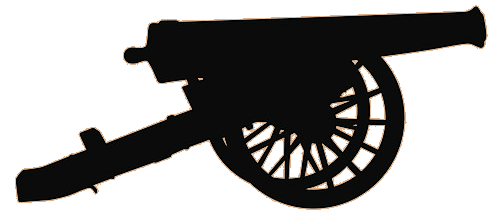

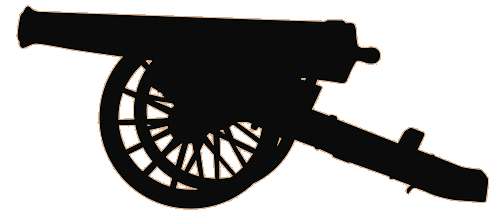


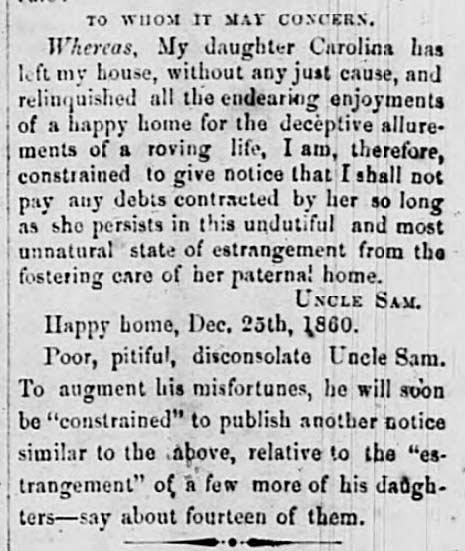





 By James
McKay, Jr. in "
By James
McKay, Jr. in "





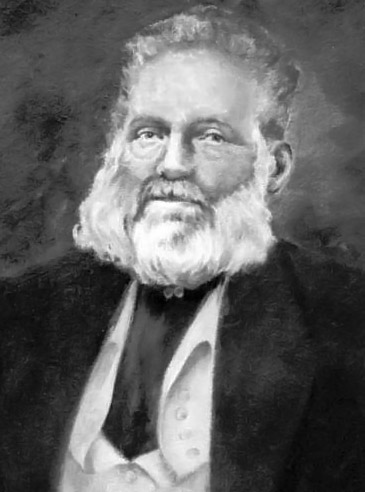








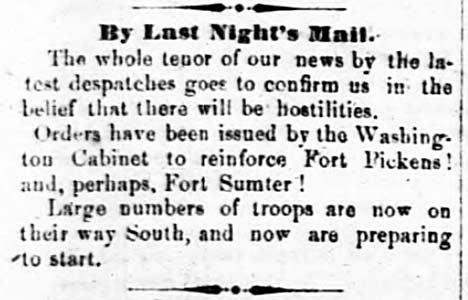
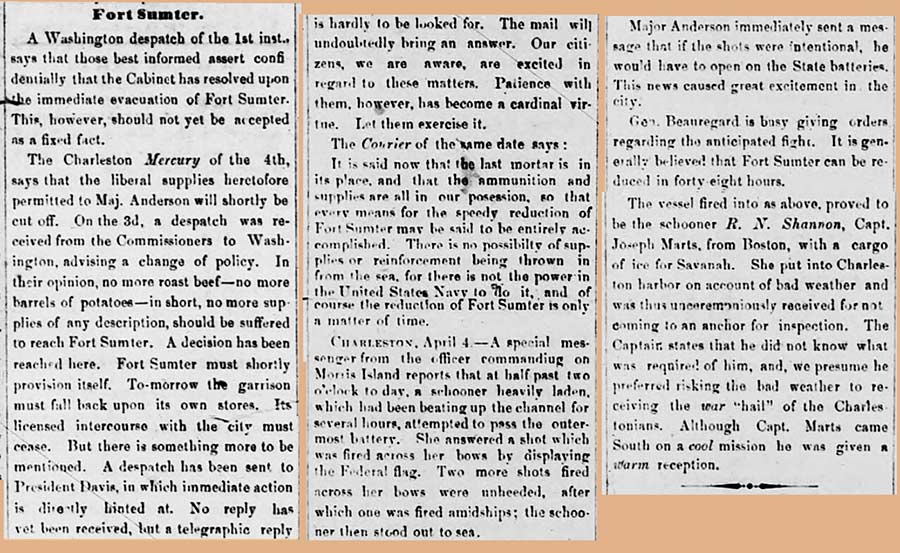
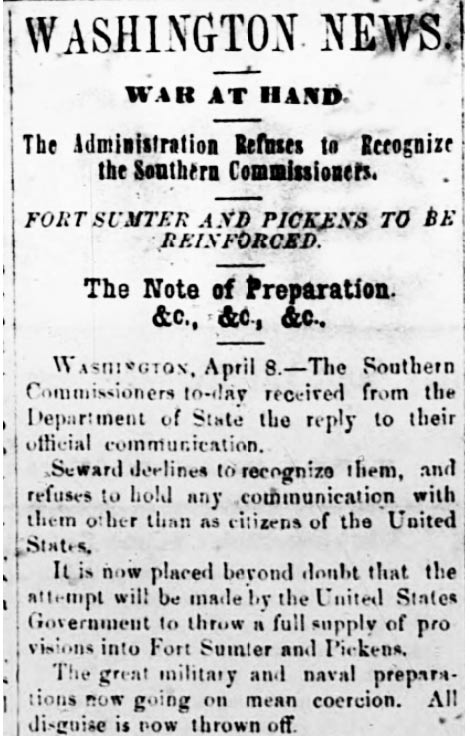
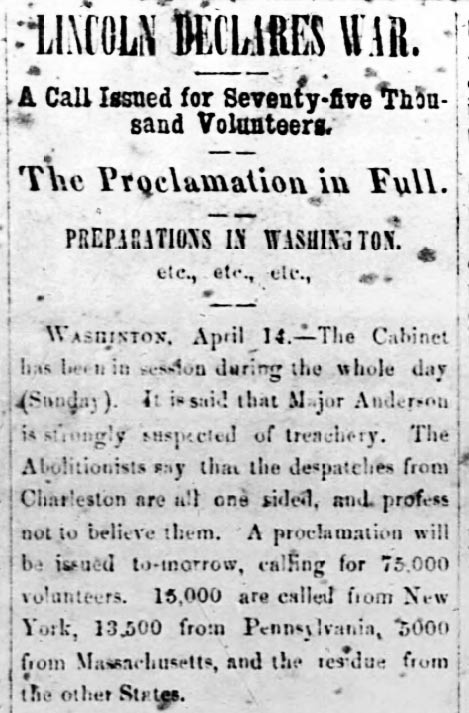
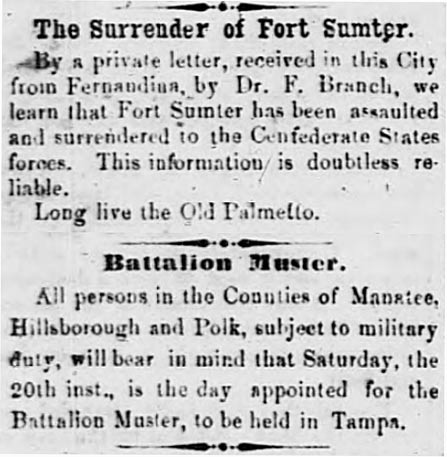
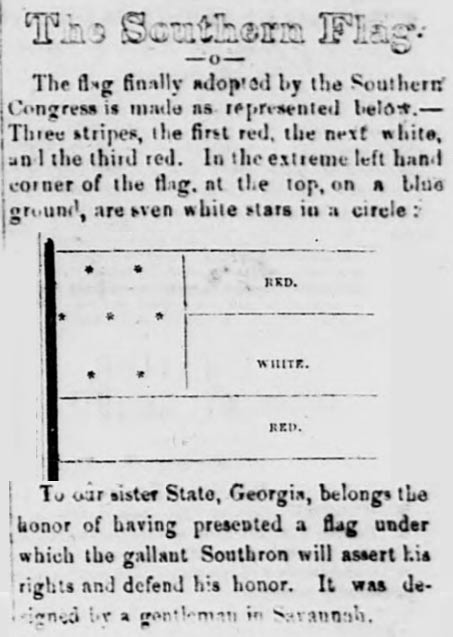
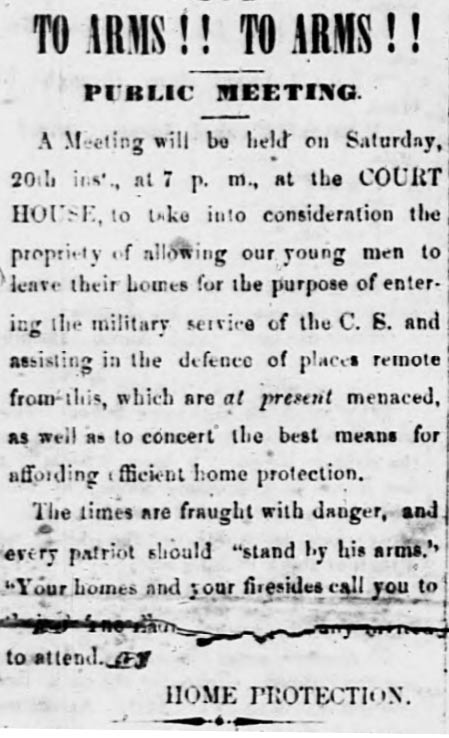




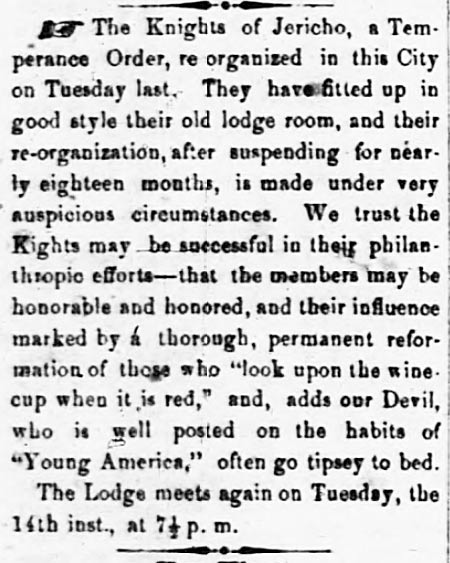
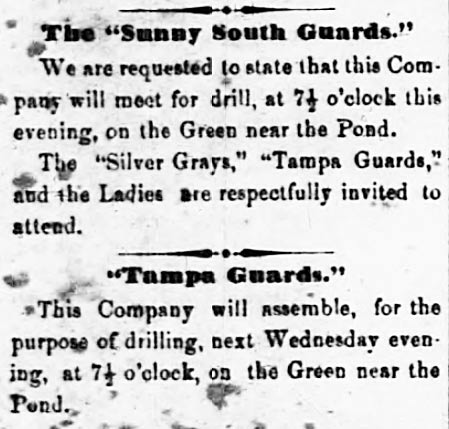




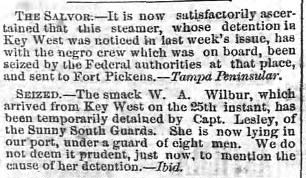

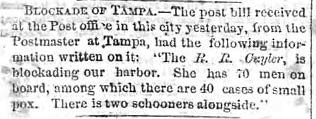












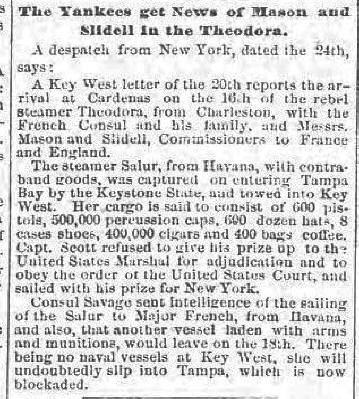
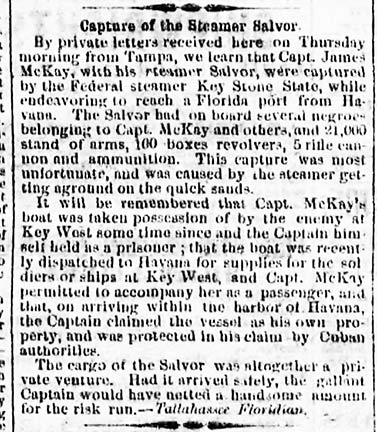



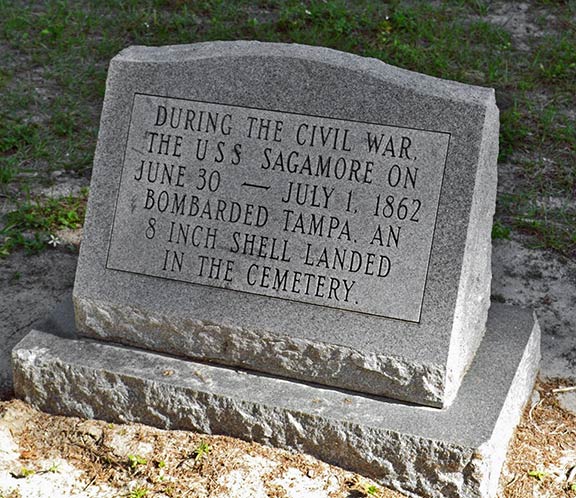



 Gov.
John Milton
Gov.
John Milton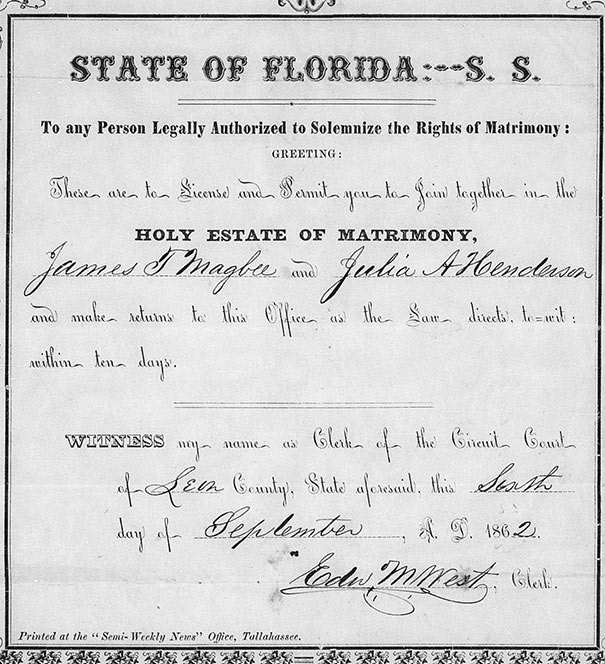



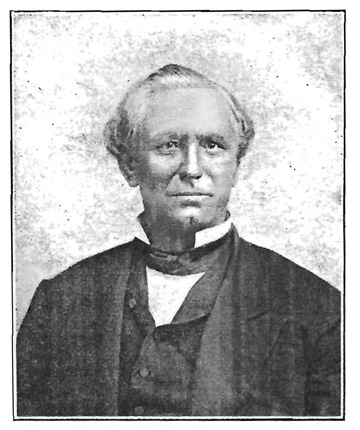



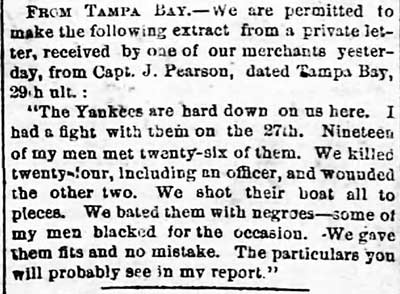
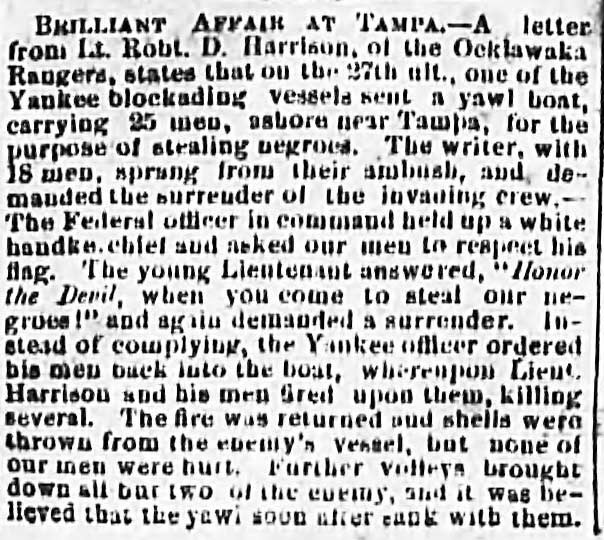
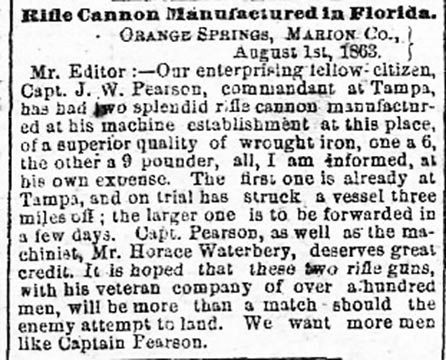
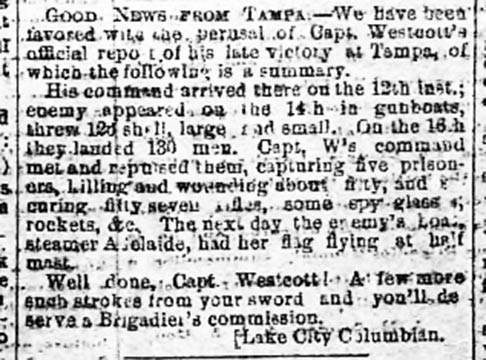


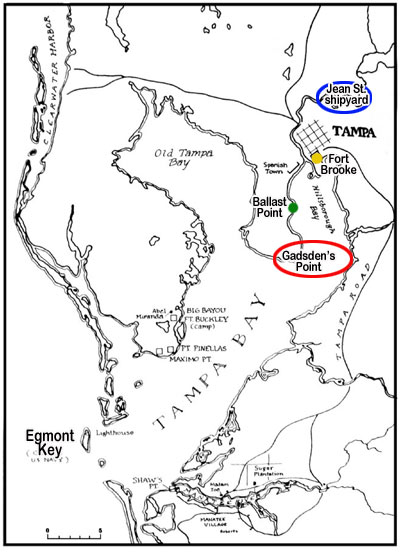
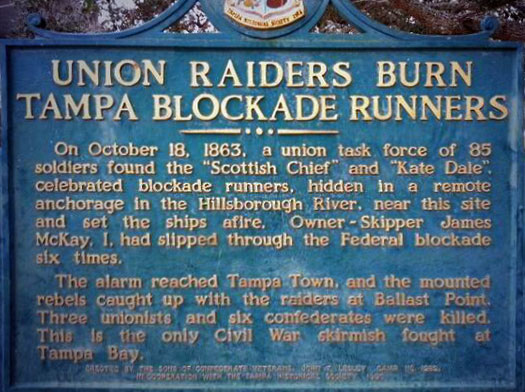







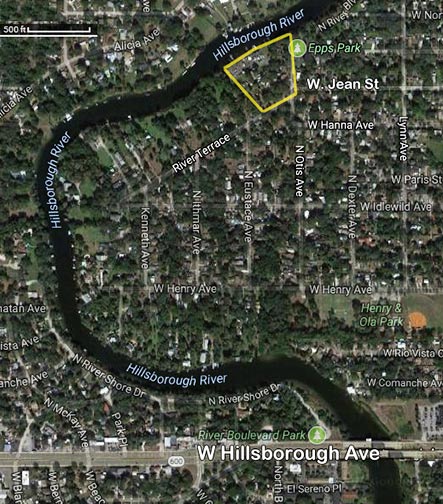
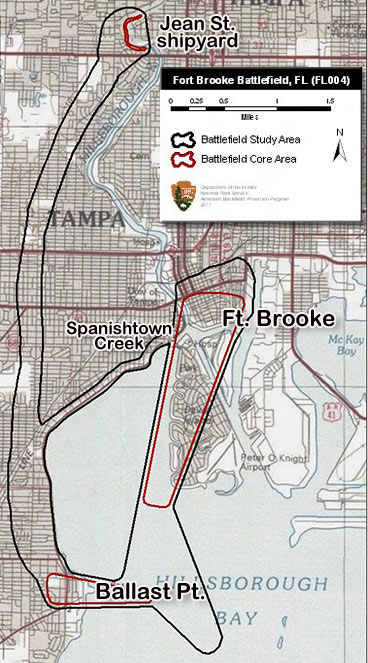
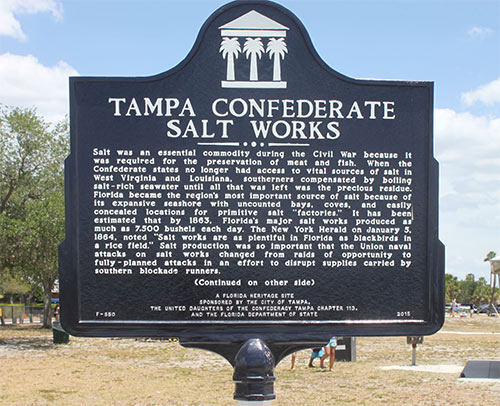
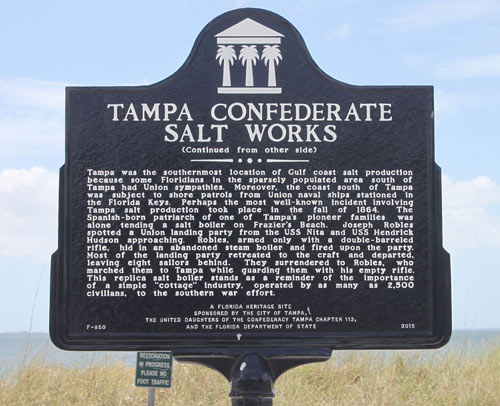
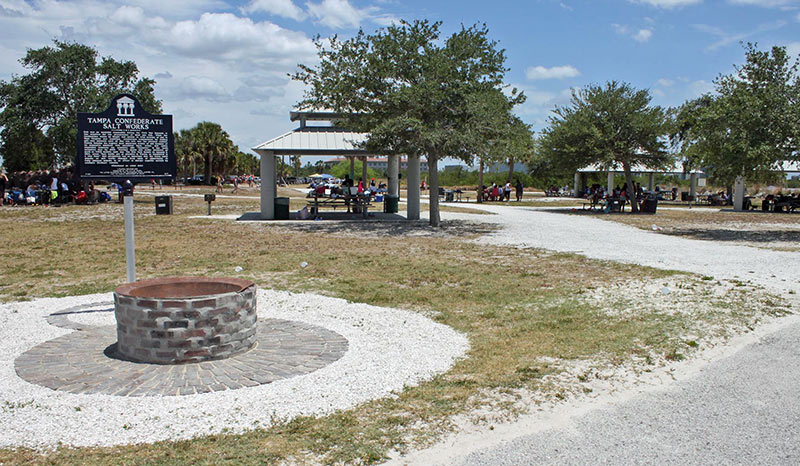
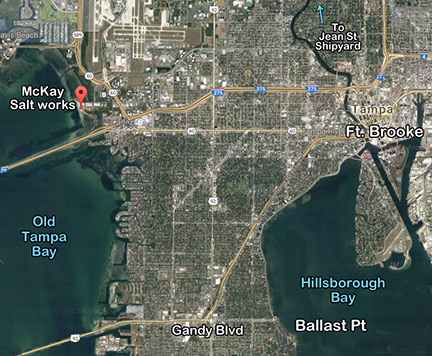







 Plant Park, April 2, 2011
Plant Park, April 2, 2011





